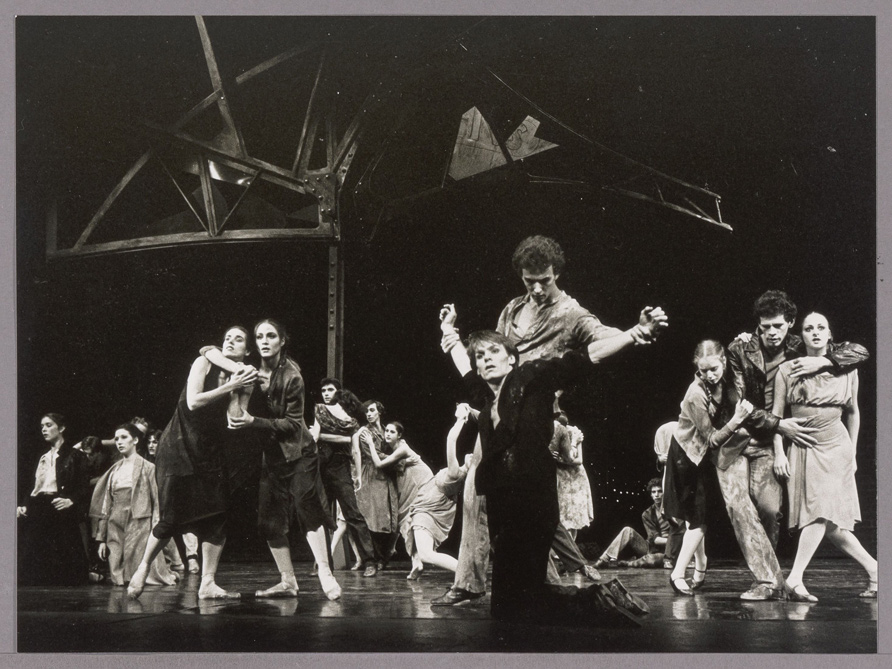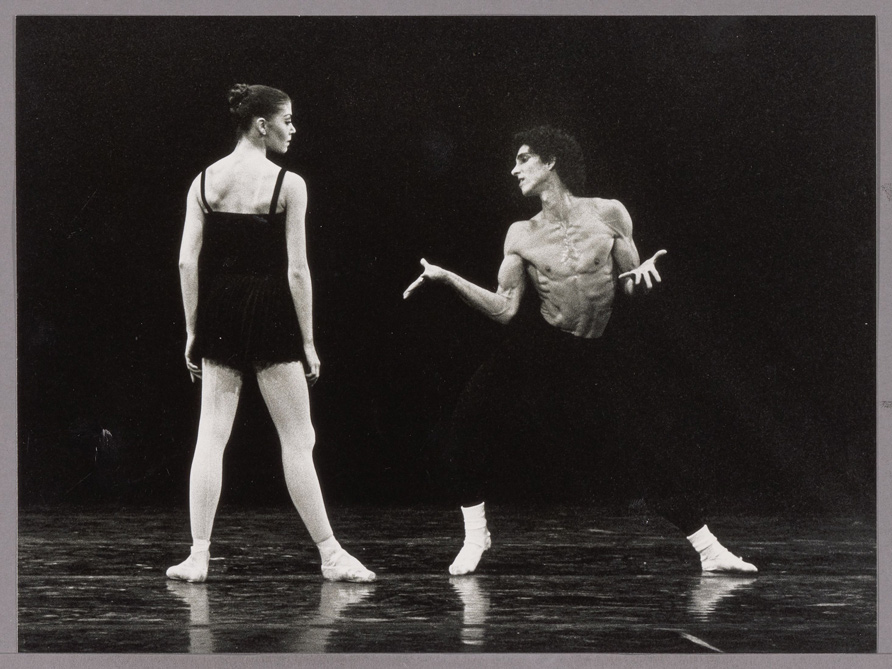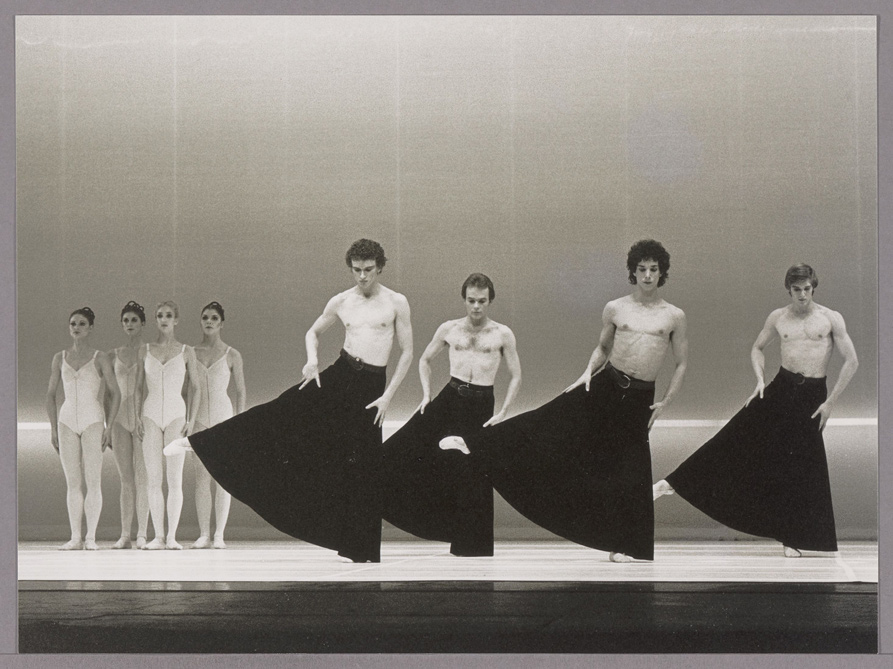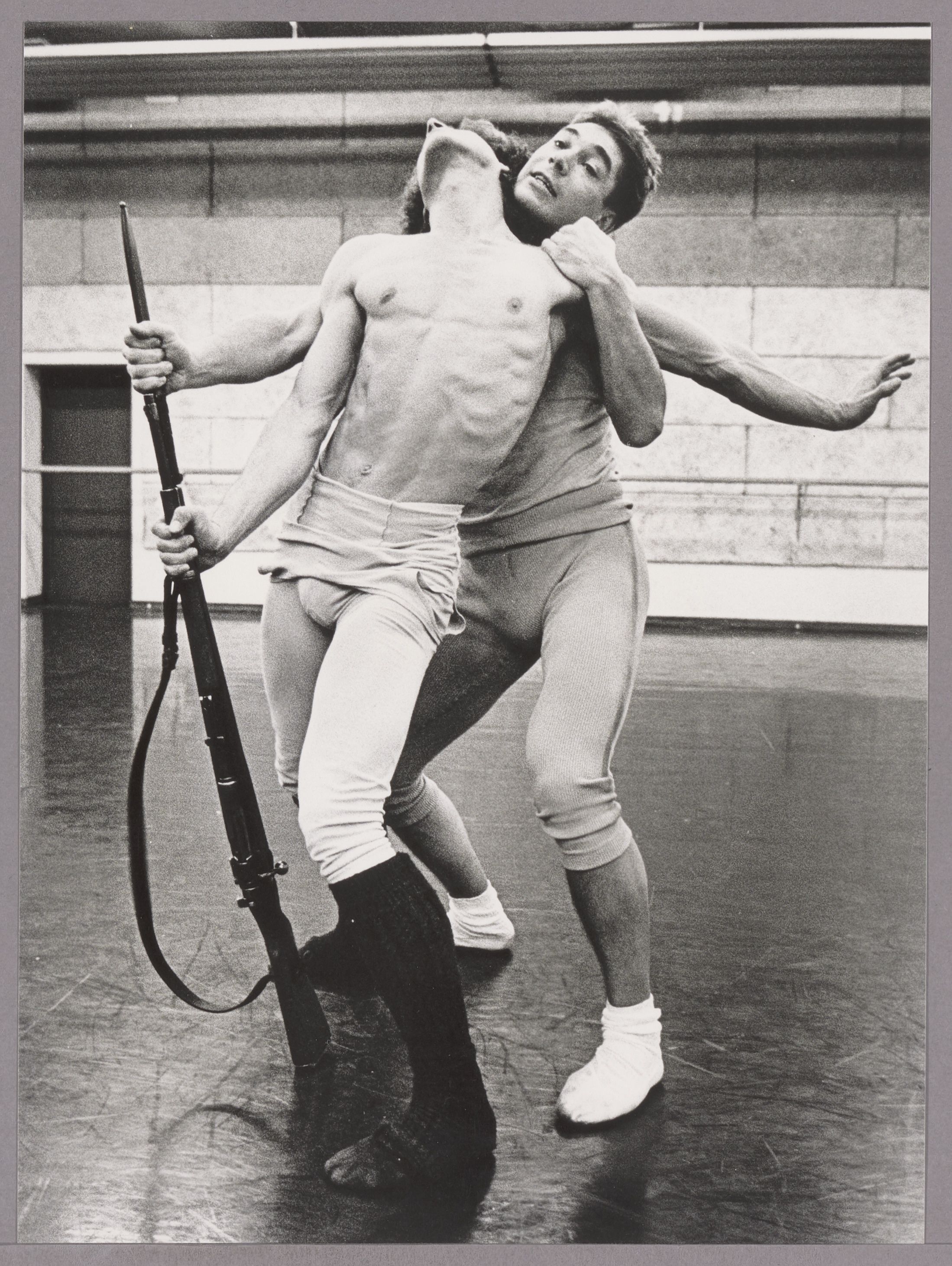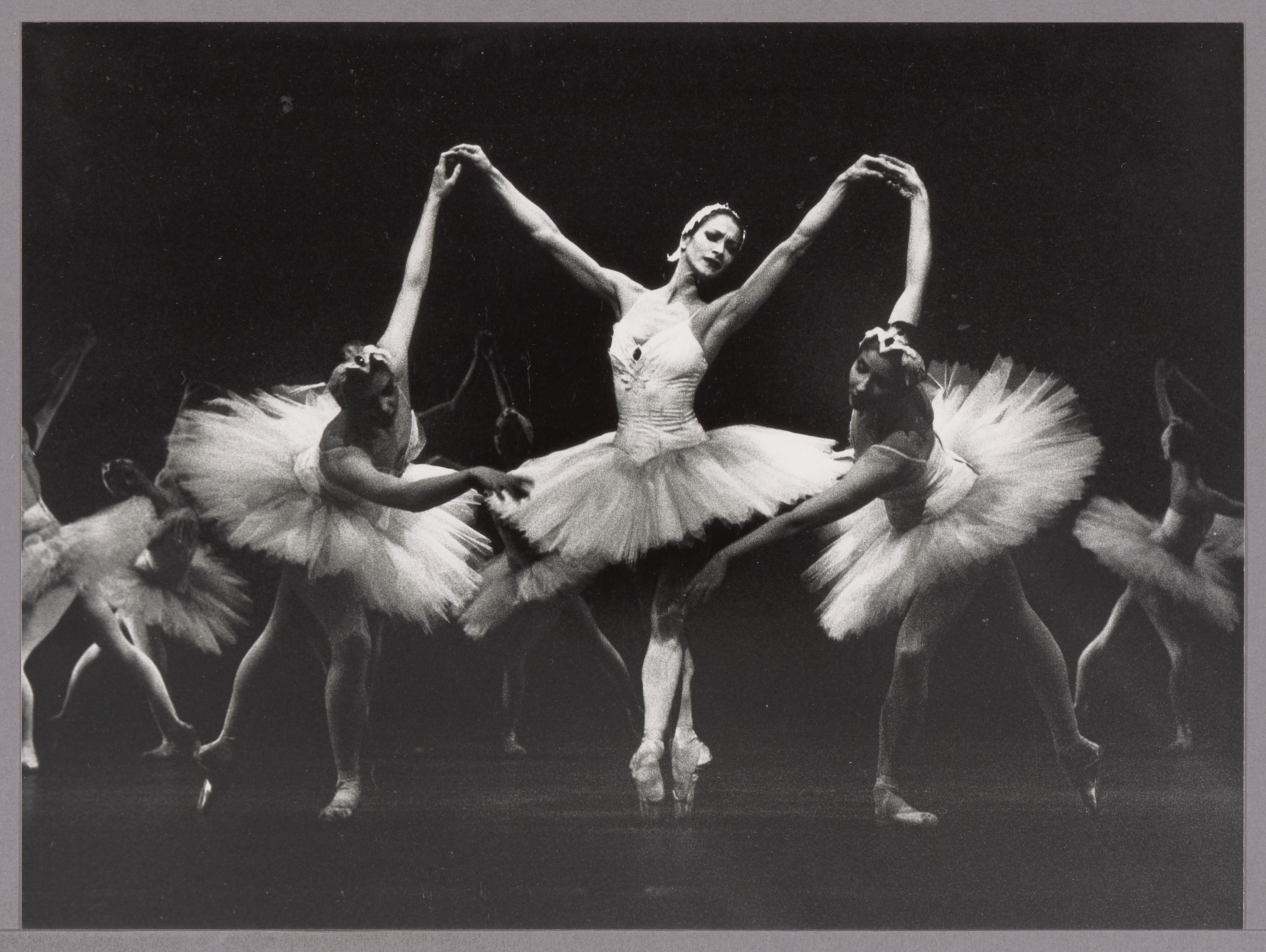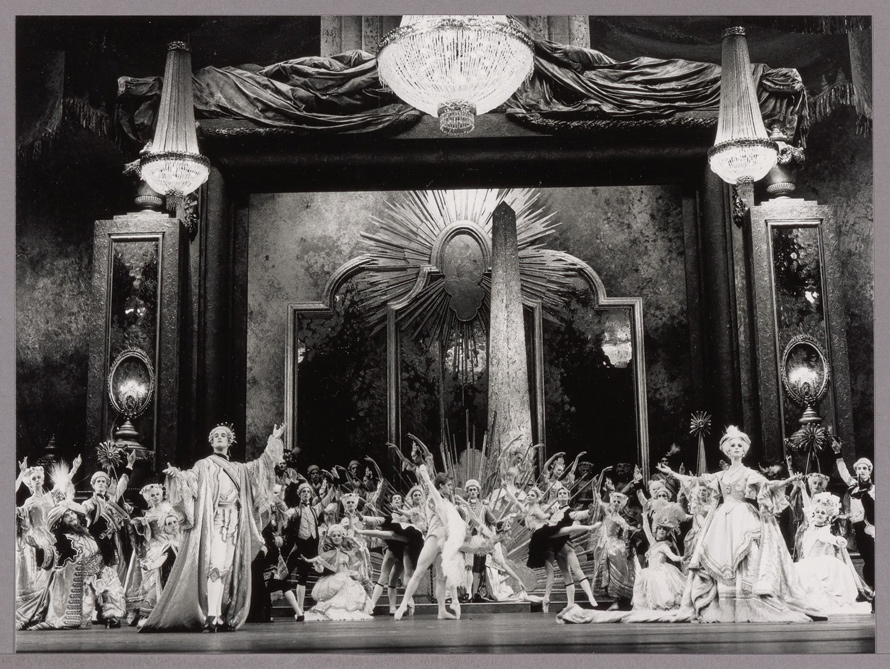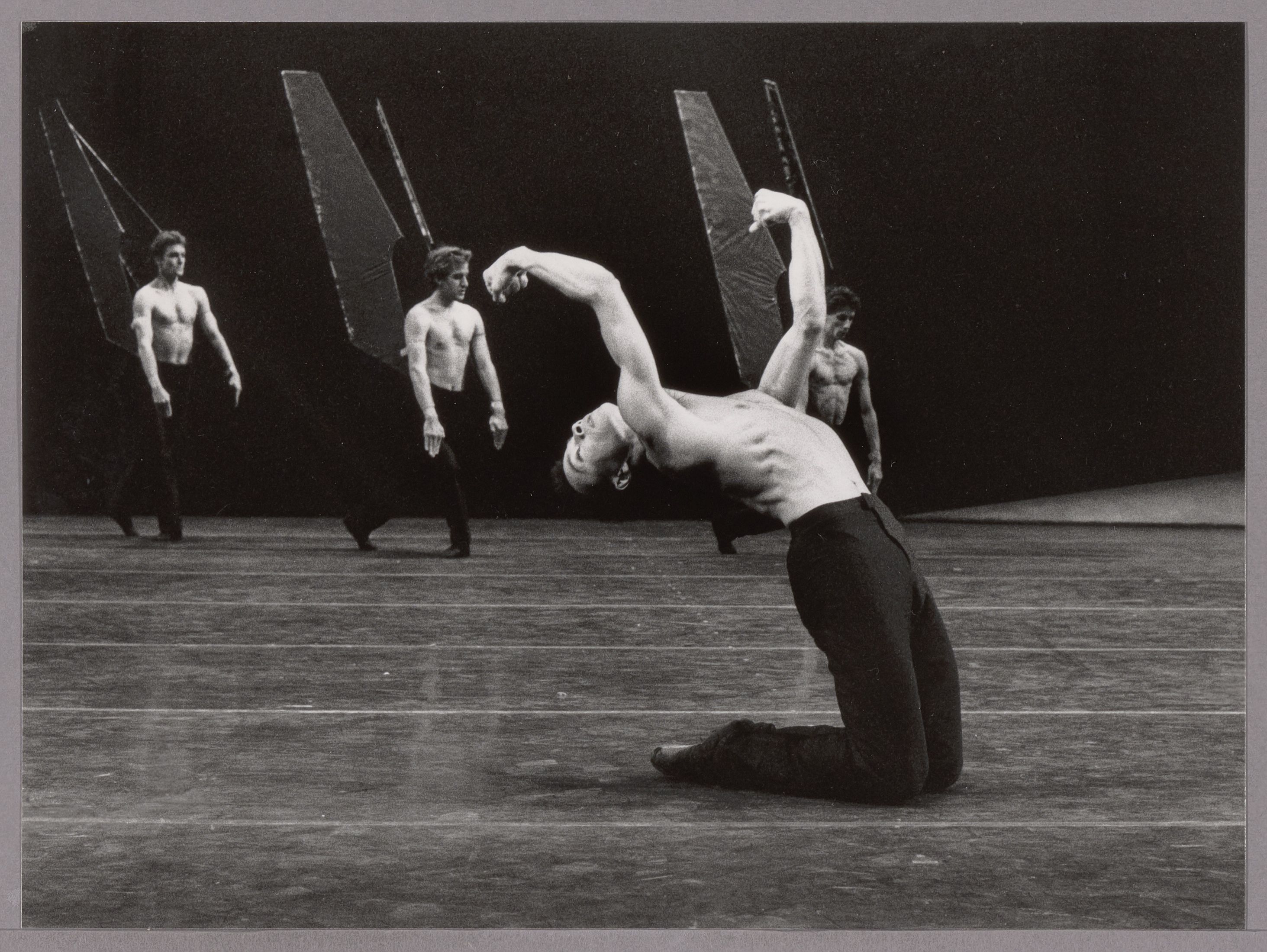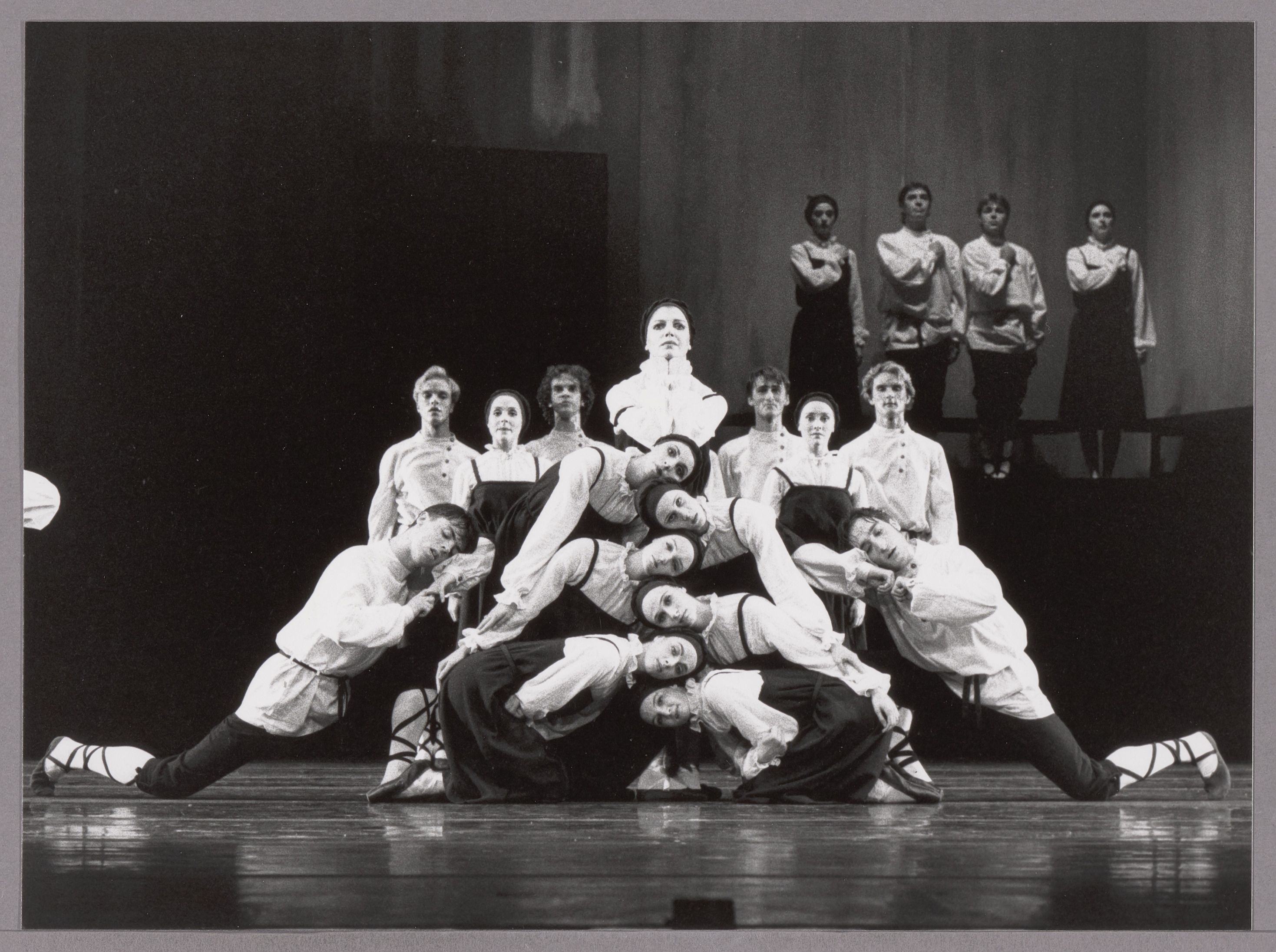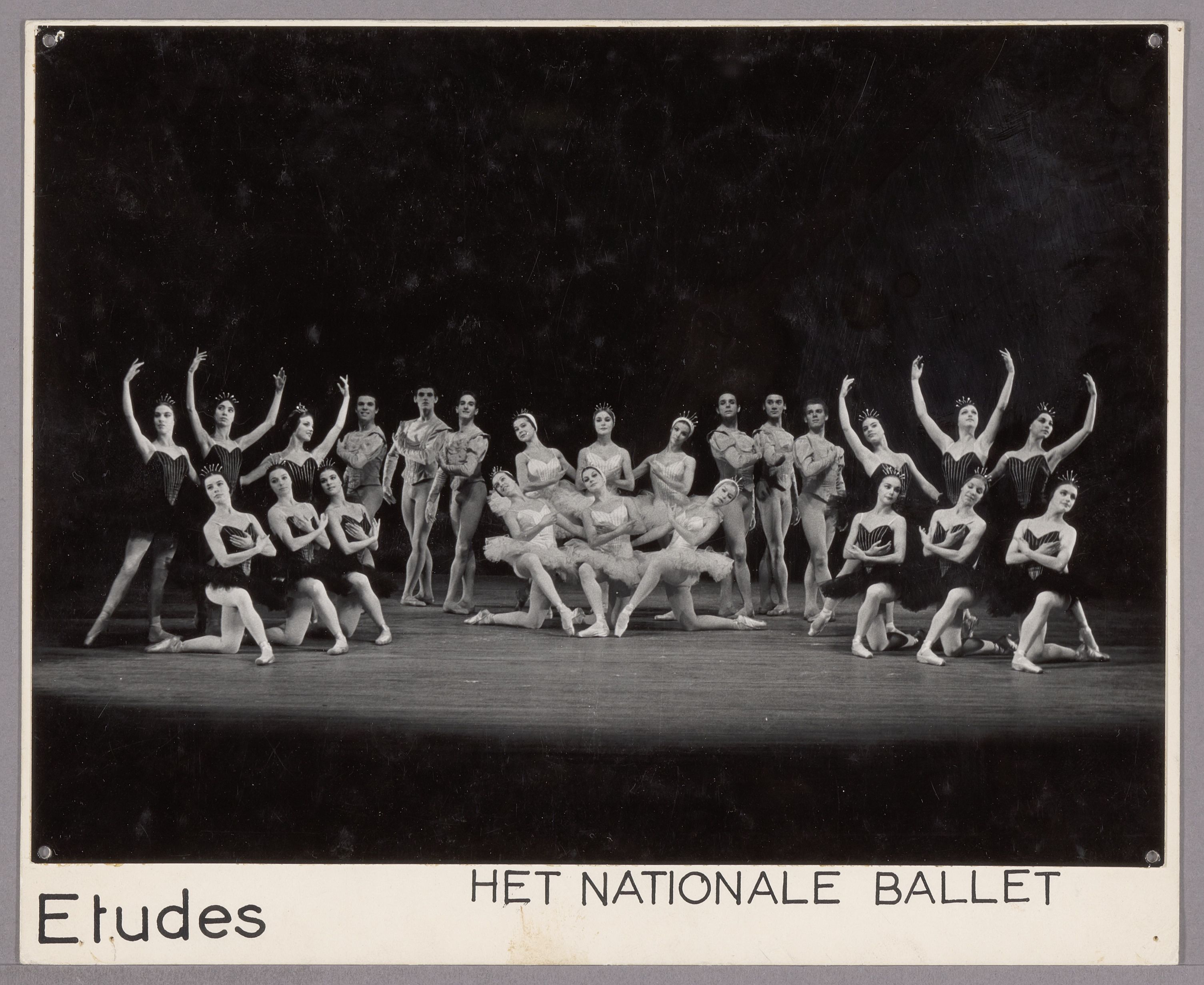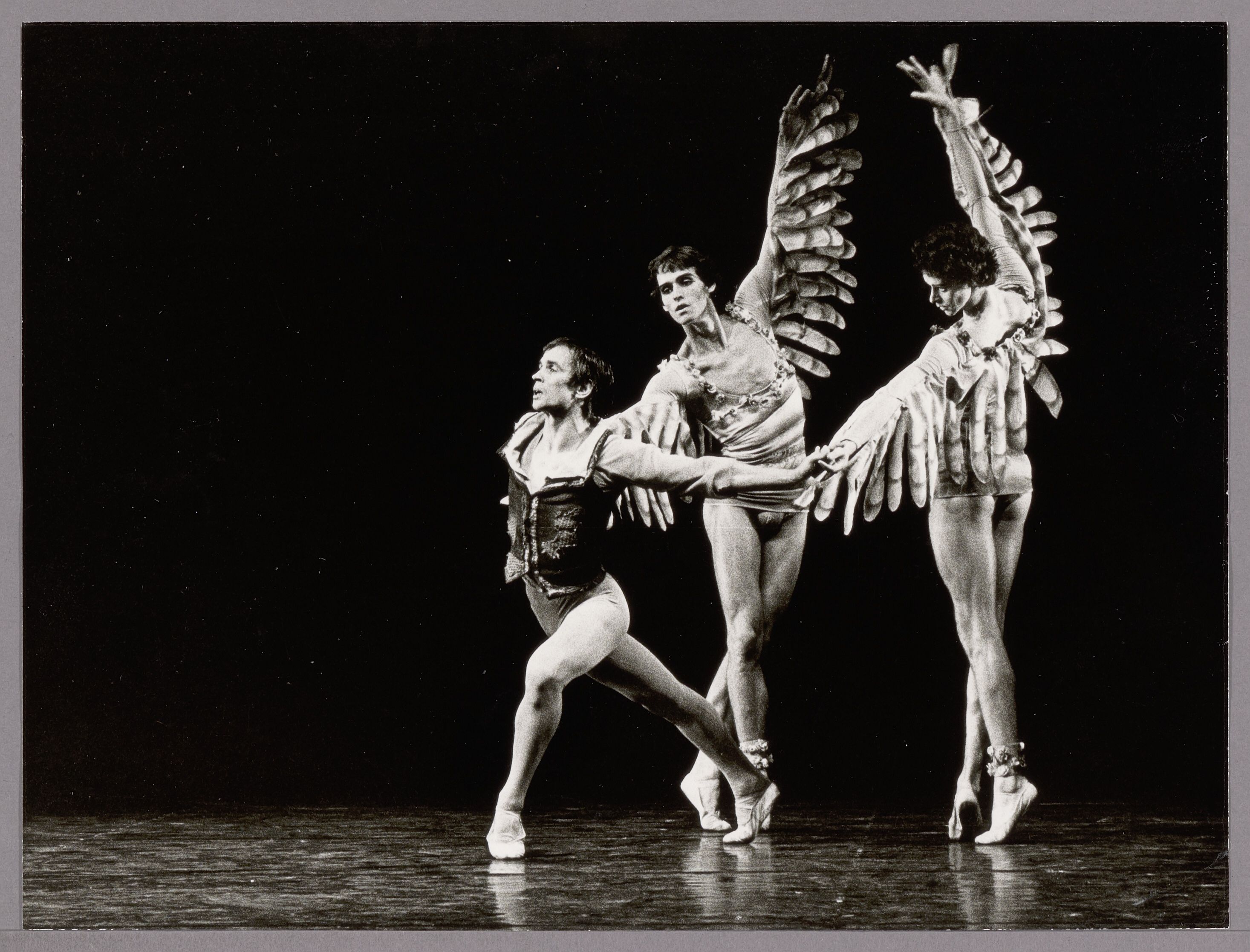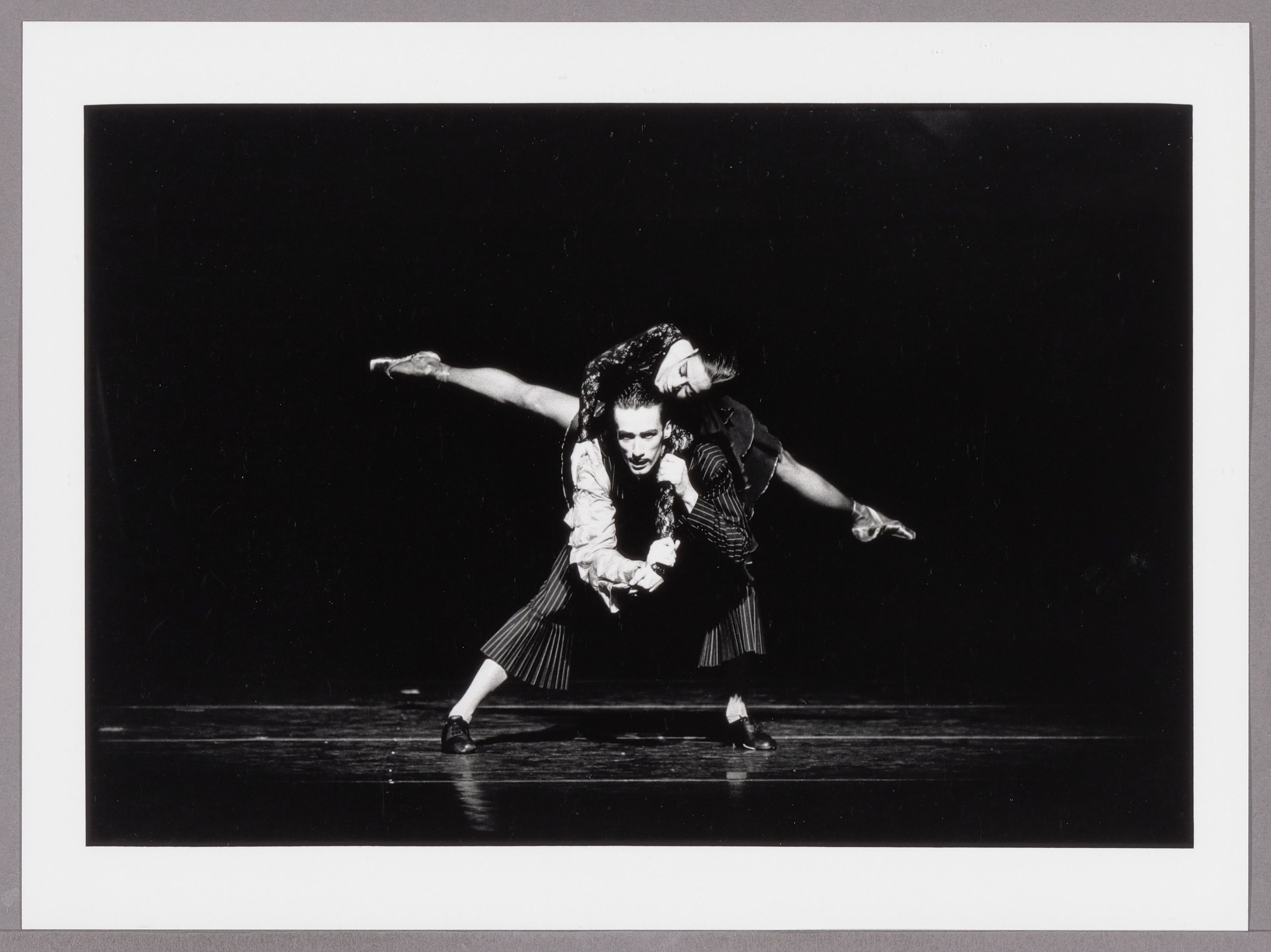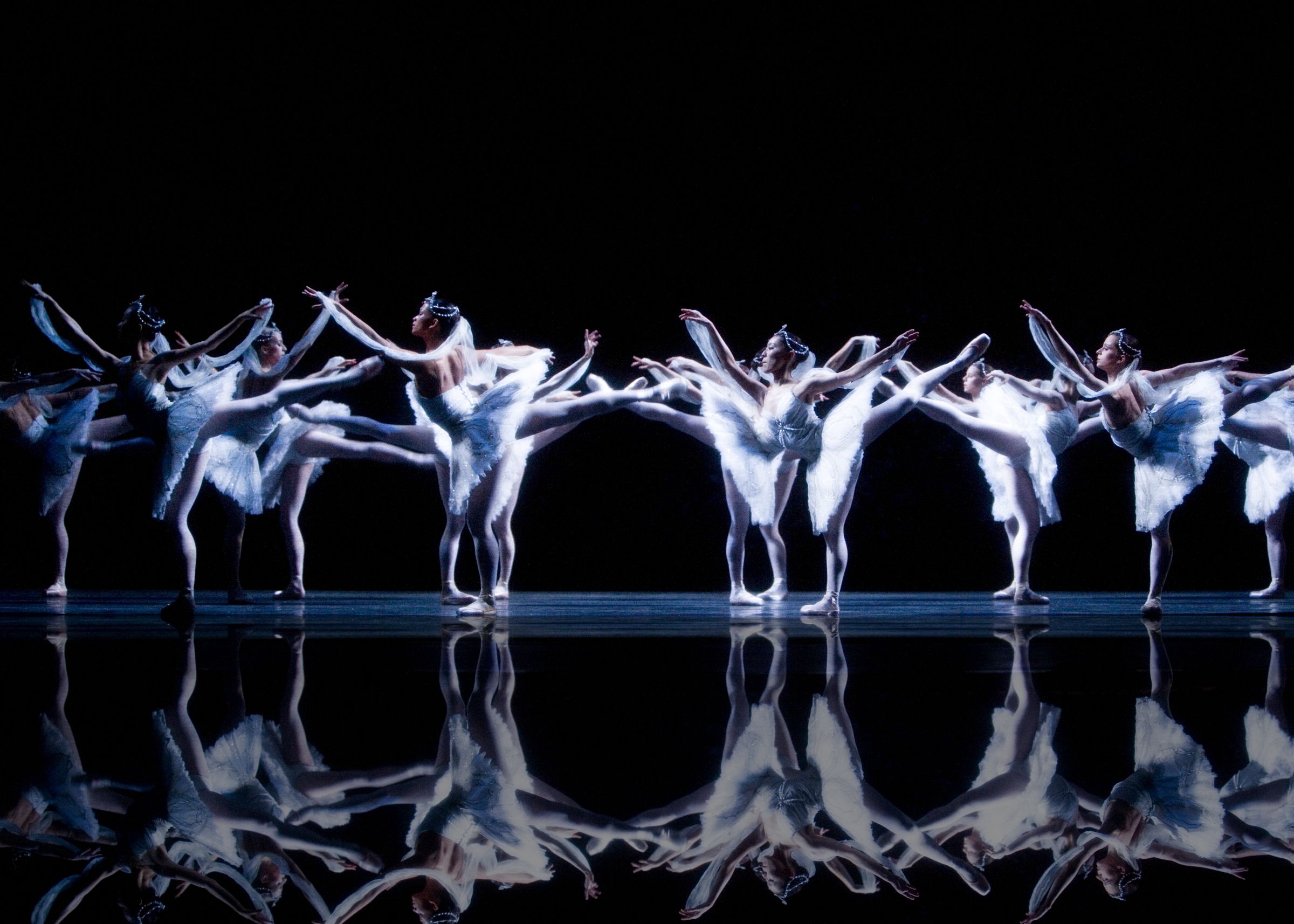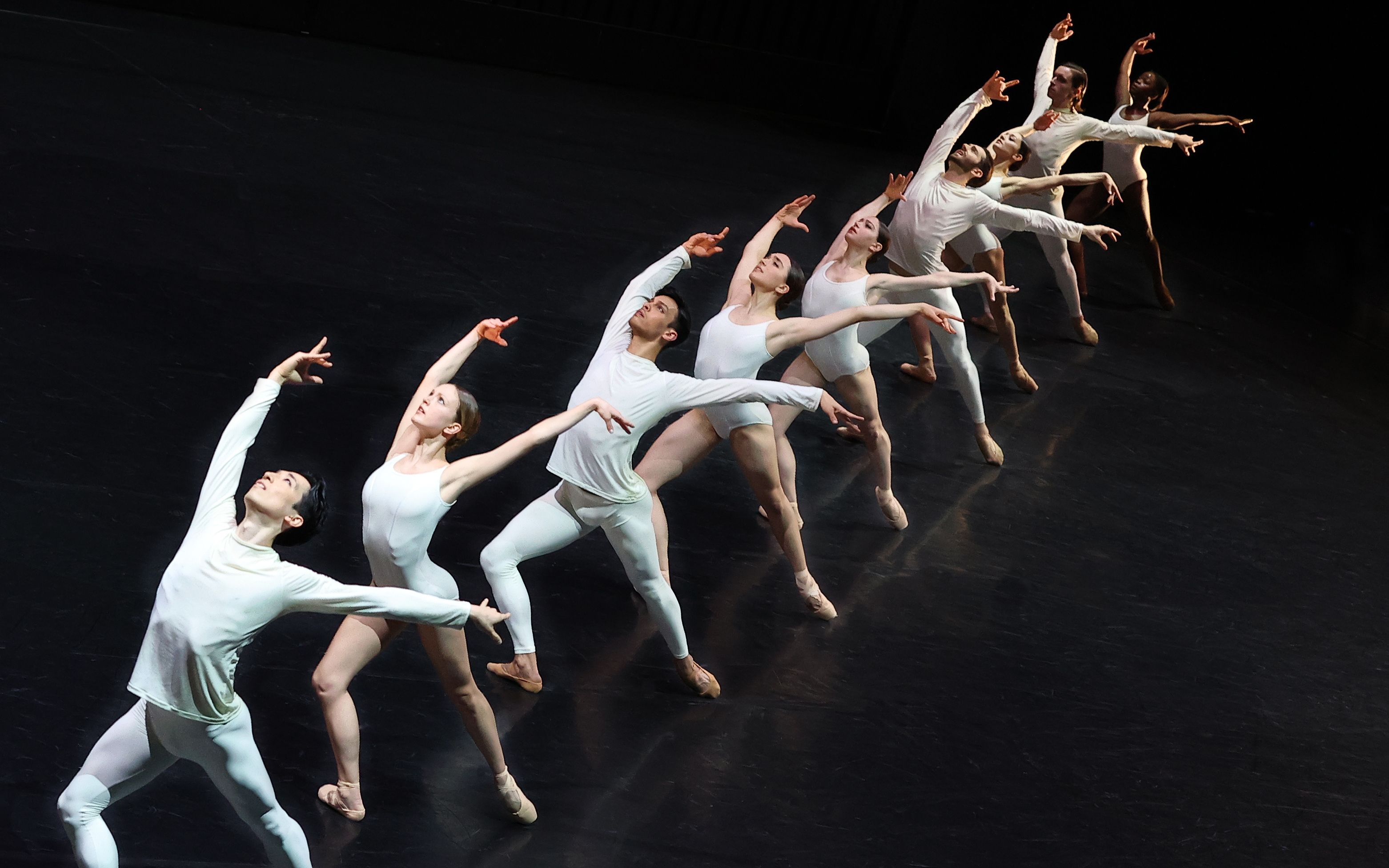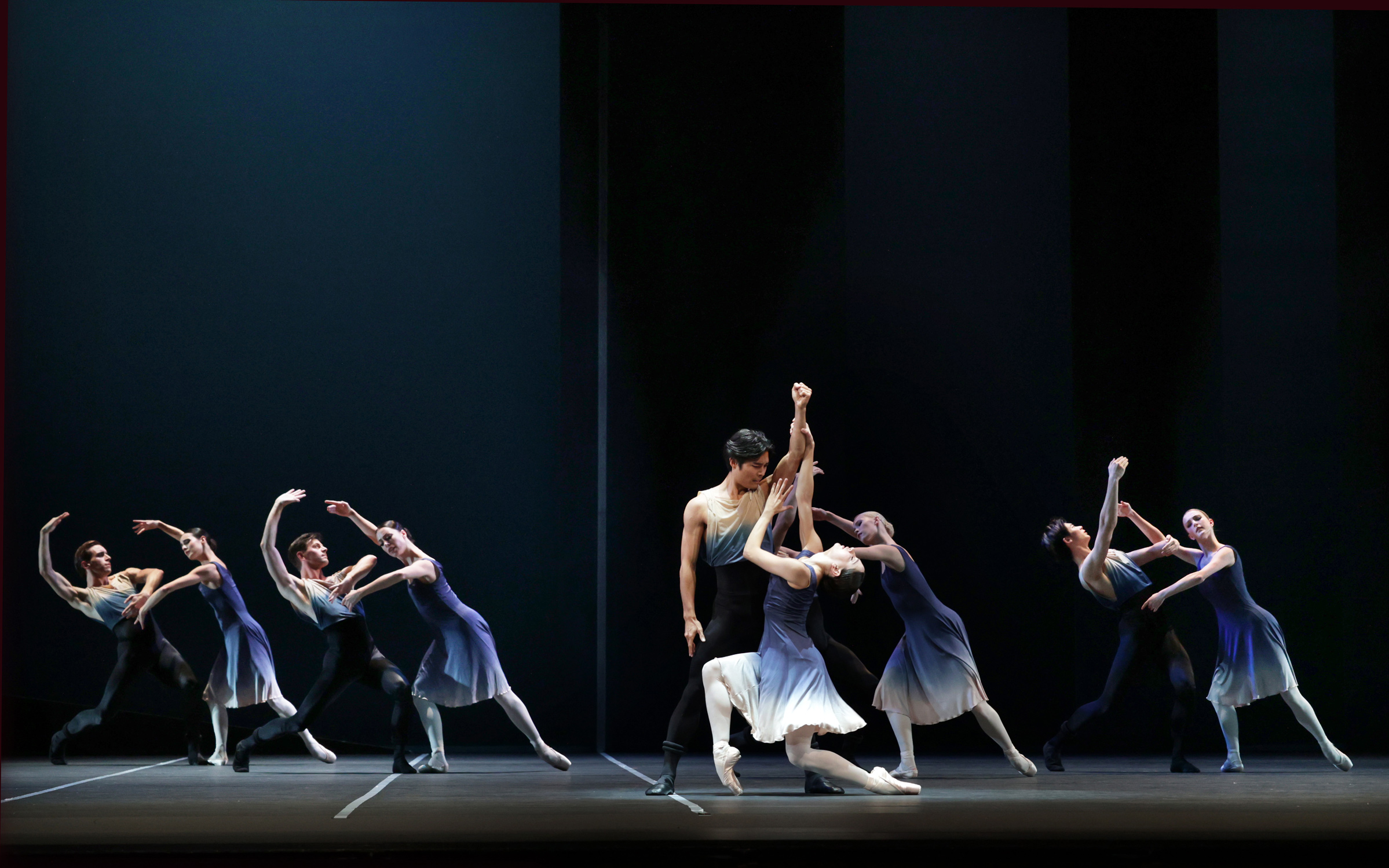
The history of Dutch National Ballet
Explore the rich history of Dutch National Ballet through this timeline, showcasing highlights from its repertoire and tracing the company’s development since its founding in 1961. Immerse yourself in captivating stories and enjoy a wealth of rarely-seen archival images.
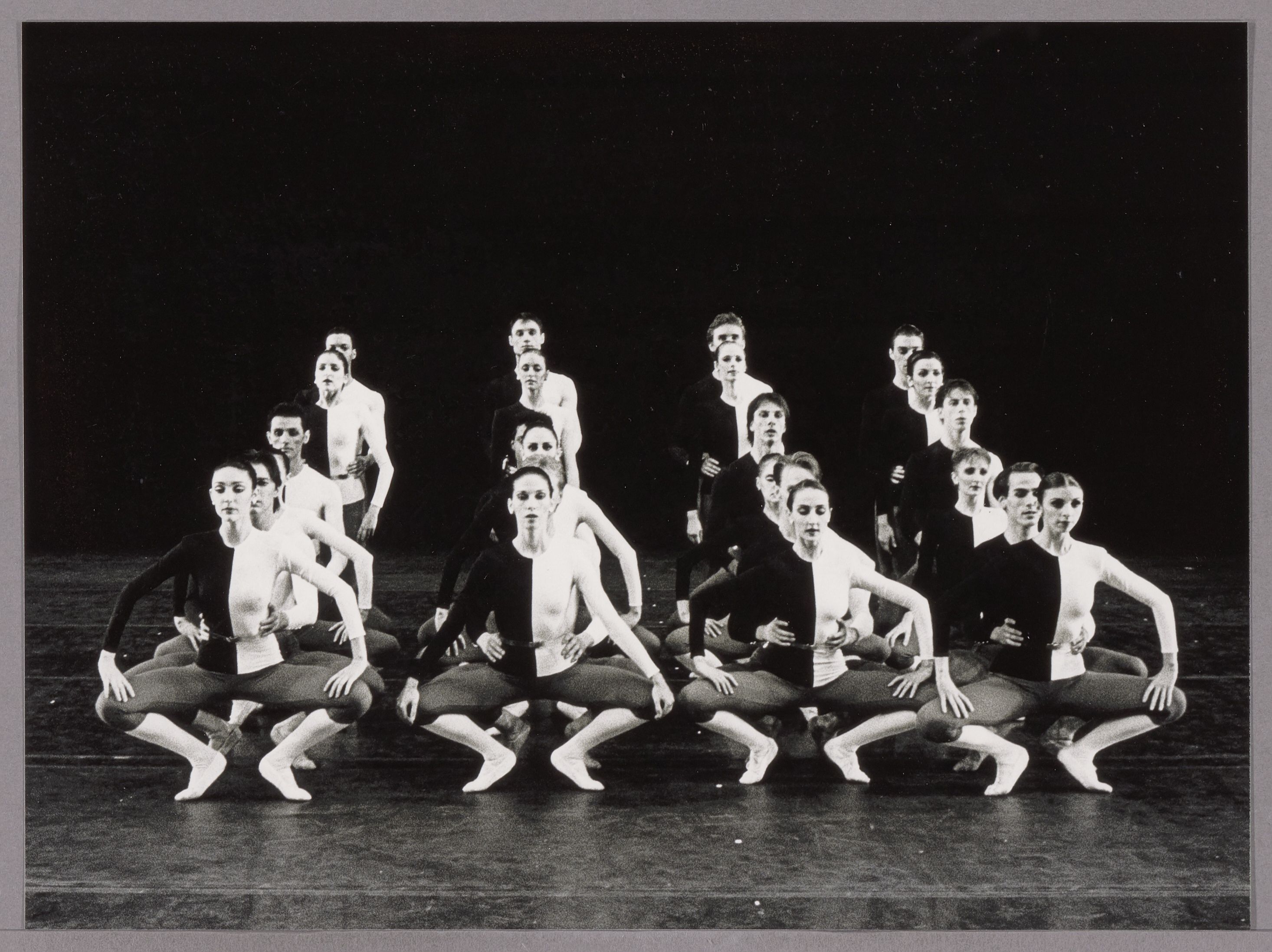
The 80s
- 124 New Productions
- 95 World Premieres
81 / 82
State visit to Bonn
On 2 March 1982, Dutch National Ballet performs (as is often the case) during a state visit by Queen Beatrix and Prince Claus, this time to Bonn. At the last moment, there are changes to the programme. For instance, Hans van Manen’s Sarcasmen is cancelled, which leads to a minor commotion or myth, as the choreographer initially presumes that one scene in the ballet – where the female dancer puts her hand on the male dancer’s crotch – is deemed ‘unsuitable’ by the Royal Family.
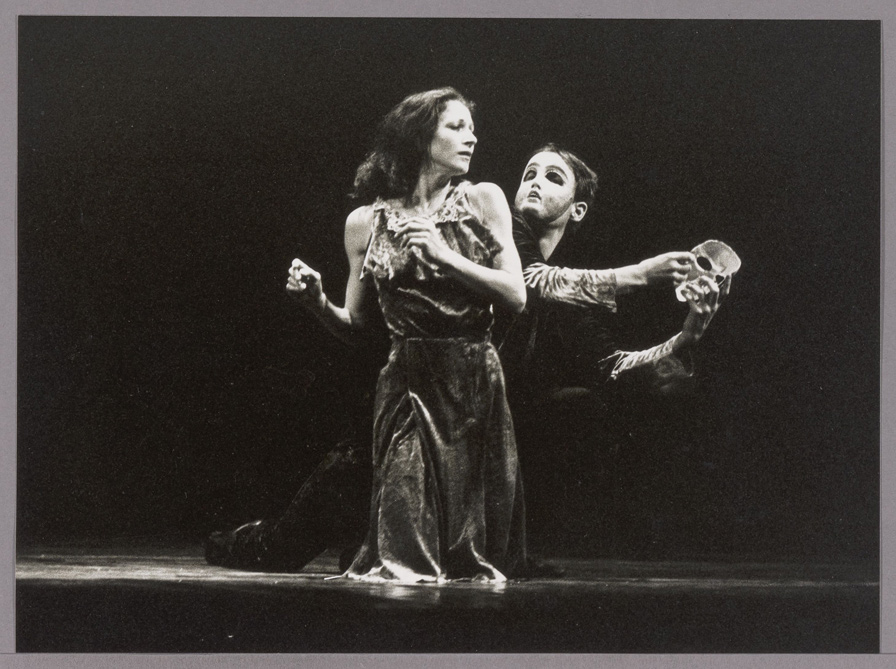
Anniversary
On the occasion of Dutch National Ballet’s 20th anniversary, the three resident choreographers each create a new work: Onder mijne voeten (Rudi van Dantzig), I Hate You Too, Johnny (Toer van Schayk) and the still regularly performed 'ballet for two' Sarcasmen (Hans van Manen), which was danced in inimitable style at the premiere by principal dancers Rachel Beaujean and Clint Farha.
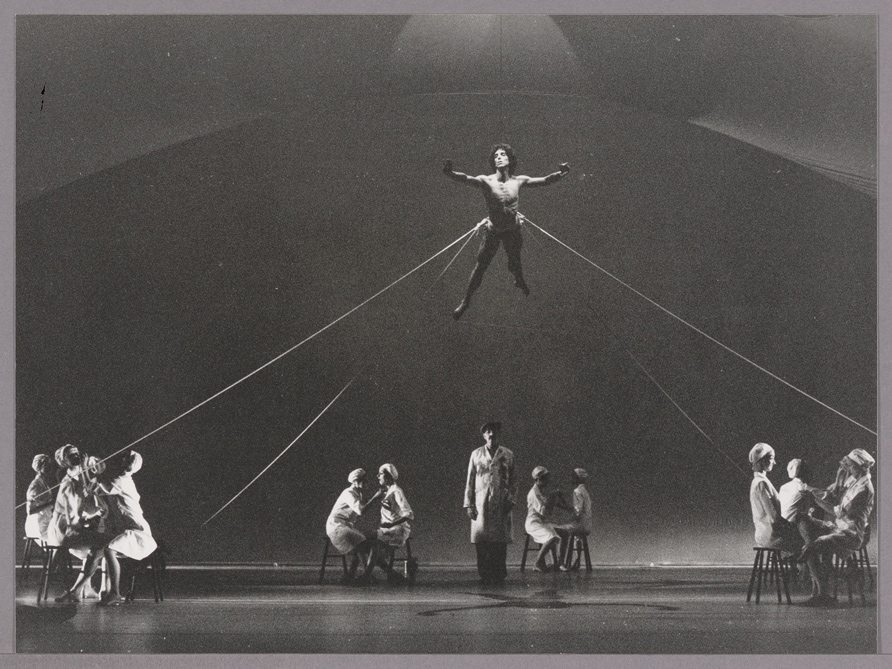
Landscape
Toer van Schayk also creates his first full-length ballet: Landscape. After Van Dantzig’s Romeo and Juliet, this is the second full-length work by a Dutch choreographer. In the kaleidoscopic, often surrealist dance spectacle, Van Schayk holds a mirror up to his audience. In a peaceful Dutch river landscape, he shows images of war, oppression, commercial science, and environmental pollution.
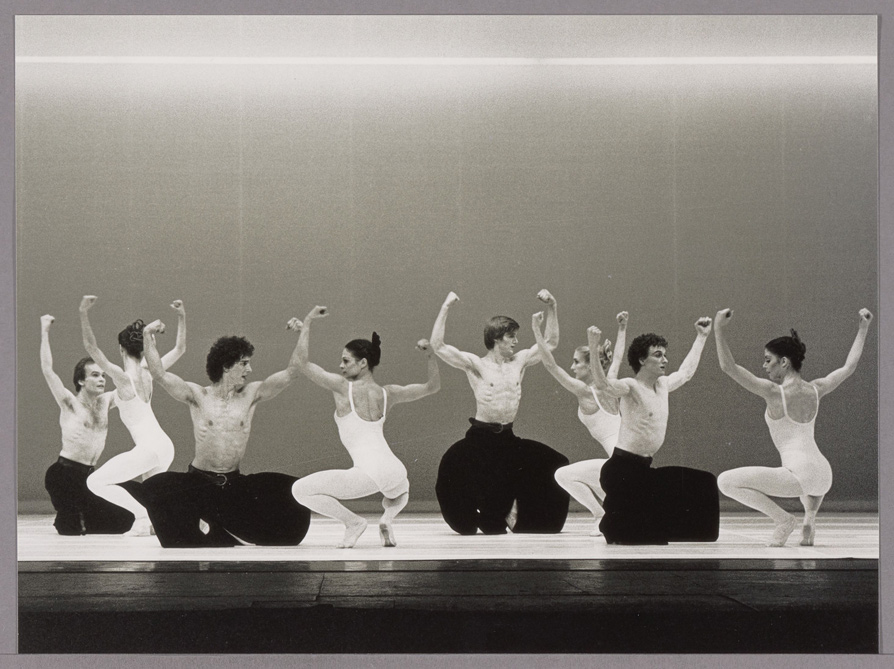
Grosse Fuge
Another important addition to the repertoire is Hans van Manen’s Grosse Fuge, originally created for Nederlands Dans Theater in 1971, when it was immediately proclaimed the “most interesting European ballet of the decade”. Today, Grosse Fuge is still one of the master choreographer’s most often performed works worldwide.
Tour Israël
The company goes on its first tour of Israel, with performances in Jerusalem, Tel Aviv, Haifa and Ein Gev.
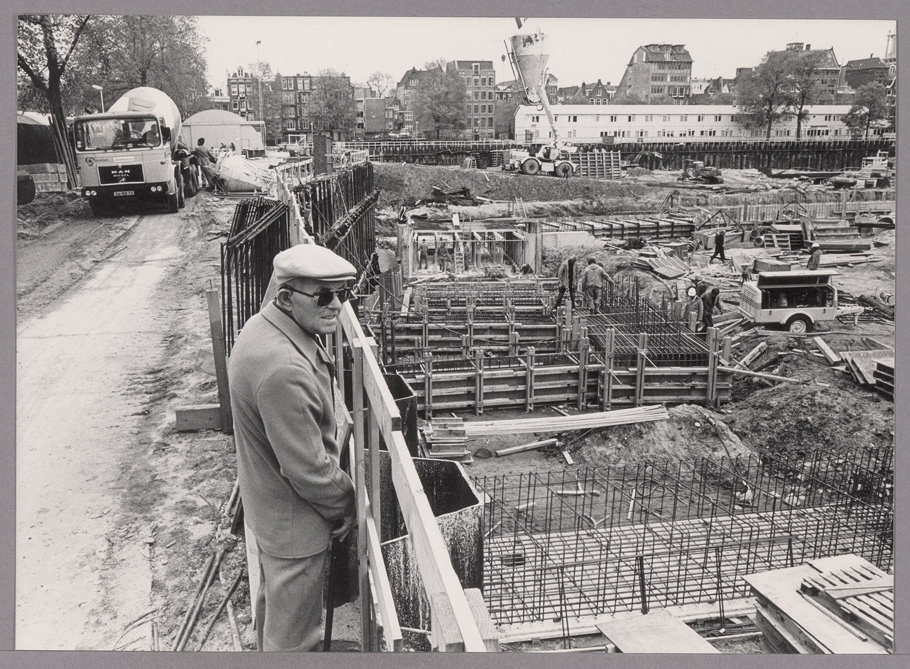
Construction of the Music Theatre starts
On 5 July 1982, the foundation stone is laid for the new City Hall and Music Theatre (now Dutch National Opera & Ballet) at Waterlooplein, Amsterdam, based on a design by the architects Wilhelm Holzbauer (City Hall) and Cees Dam (Music Theatre). The building is still popularly known by its nickname ‘Stopera’; wrongly so, as this name refers to earlier protests against the new building called ‘Stop Opera’.
82 / 83
BAM Dance Festival, New York
Dutch National Ballet performs in New York for the third time. At a dance festival at the Brooklyn Academy of Music (BAM), 13 performances are given (to audiences of 15,050) of an all-Dutch programme, with works by resident choreographers Rudi van Dantzig, Hans van Manen and Toer van Schayk.
"By offering a repertory consisting entirely of serious contemporary works, the Dutch have paid tribute to the intelligence of New York dancegoers, and for this they deserve great praise", writes The New York Times.
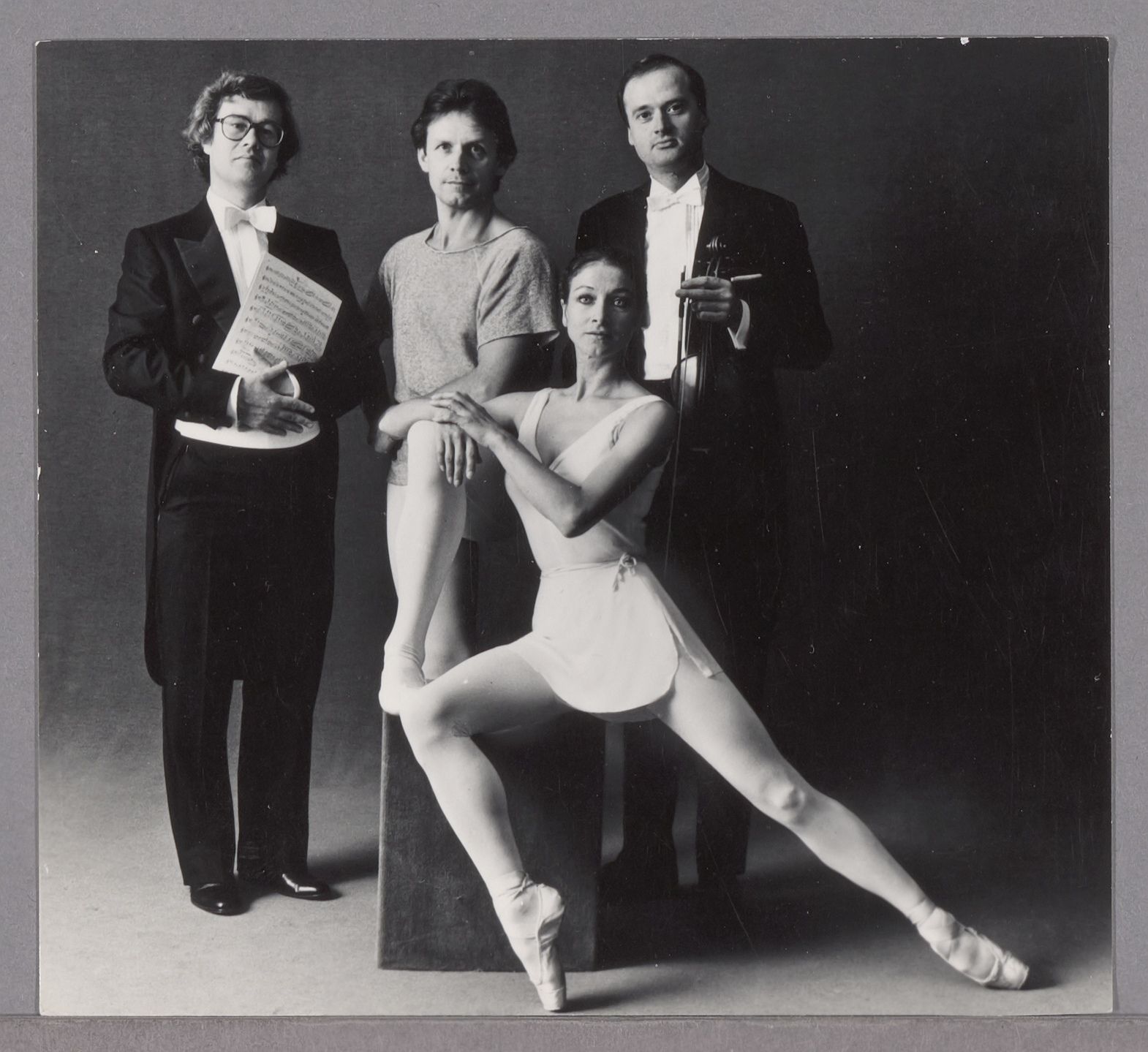
Golden Theatre Dance Prize for Alexandra Radius
Alongside its annual theatre awards, the Dutch Association of Theatres and Concert Halls (VSCD) presents its first dance awards this season. Principal dancer Alexandra Radius receives the Golden Theatre Dance Prize for her excellent interpretation of the main role in The Sleeping Beauty.
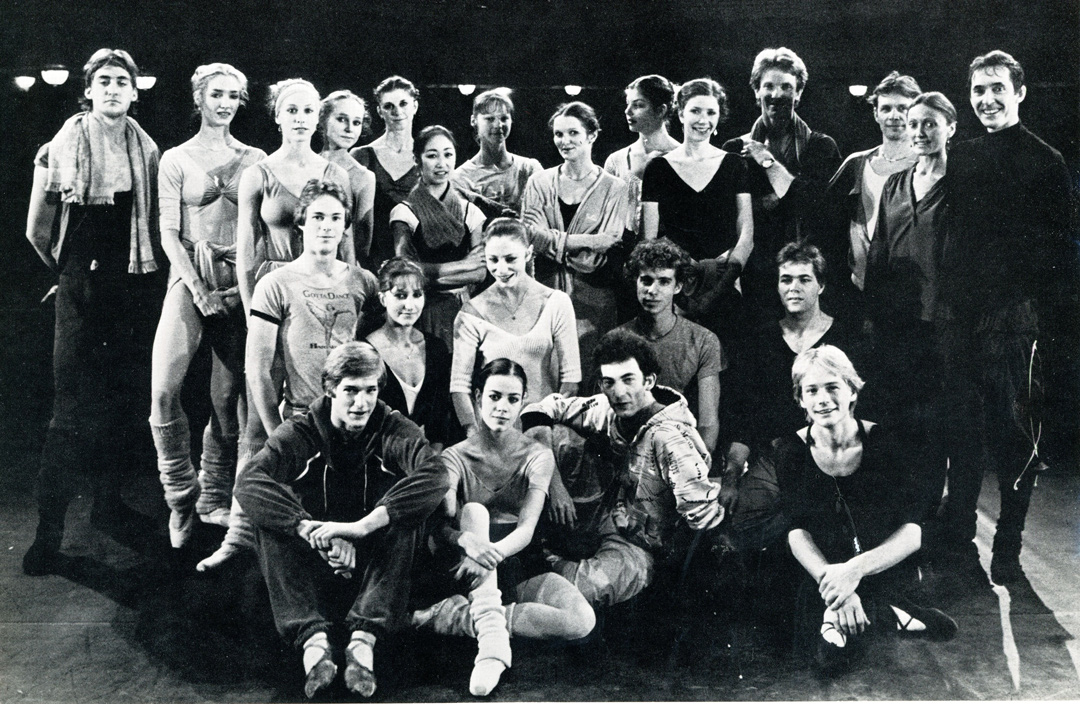
Young Stars of Dance
A new initiative is the programme Young Stars of Dance, with which Dutch National Ballet tours the Netherlands, giving upcoming young soloists the chance to gain experience in the classical and neo-classical repertoire.
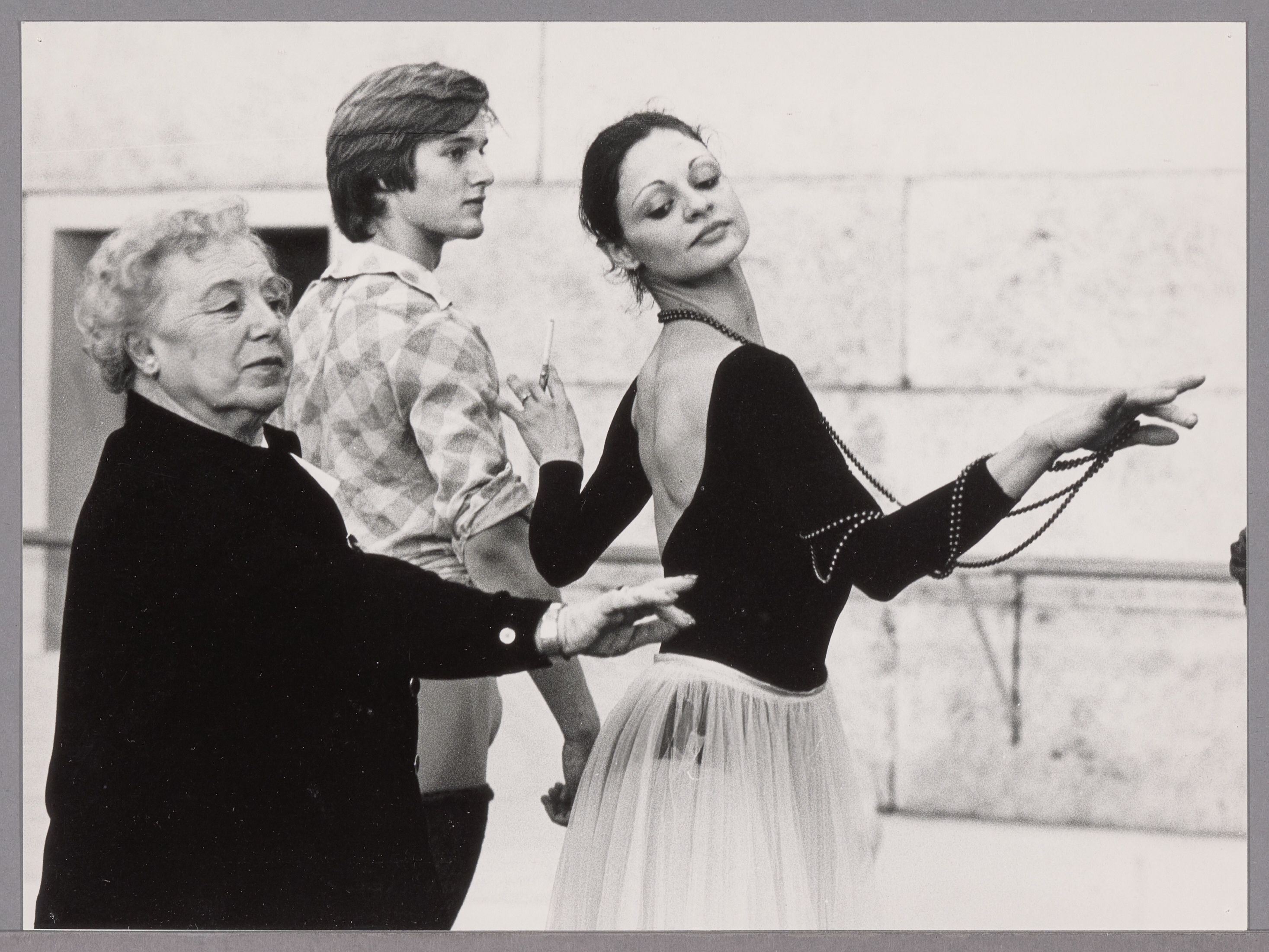
Nijinska's Les Biches
This season, Dutch National Ballet adds its first ballet to the repertoire by Bronislava Nijinska, the sister of the legendary dancer and choreographer Vaslav Nijinsky. Nijinska created Les Biches in 1924 for Diaghilev’s Ballet Russes, when she danced the role of the hostess herself. Les Biches is taught to Dutch National Ballet by her daughter, Irina Nijinska.
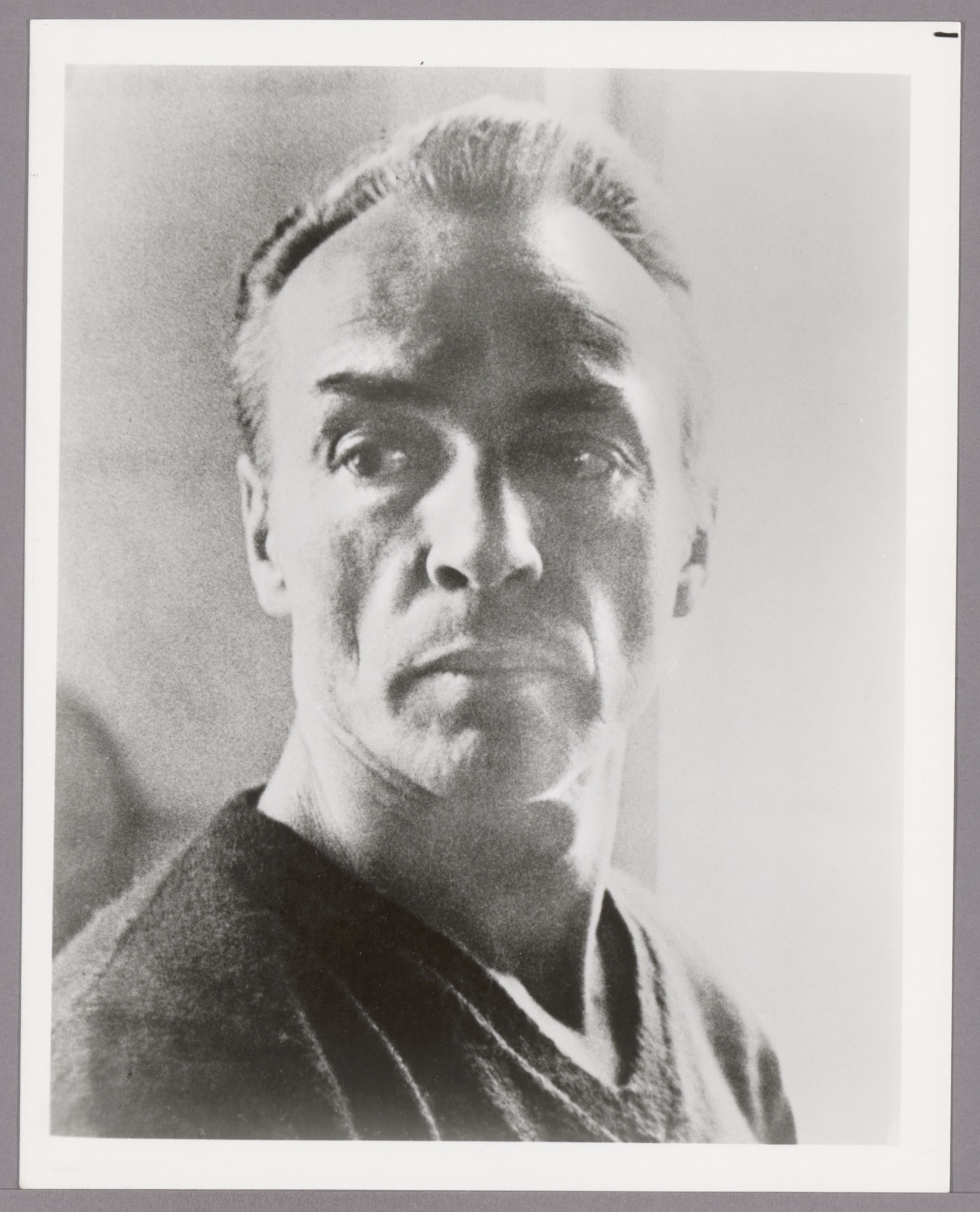
George Balanchine dies at the age of 79
George Balanchine, the Russian-American master of 20th-century ballet, dies on 30 April 1983. From the year the company was founded up to the present day, his ingenious ballets have occupied a special place in Dutch National Ballet’s repertoire.
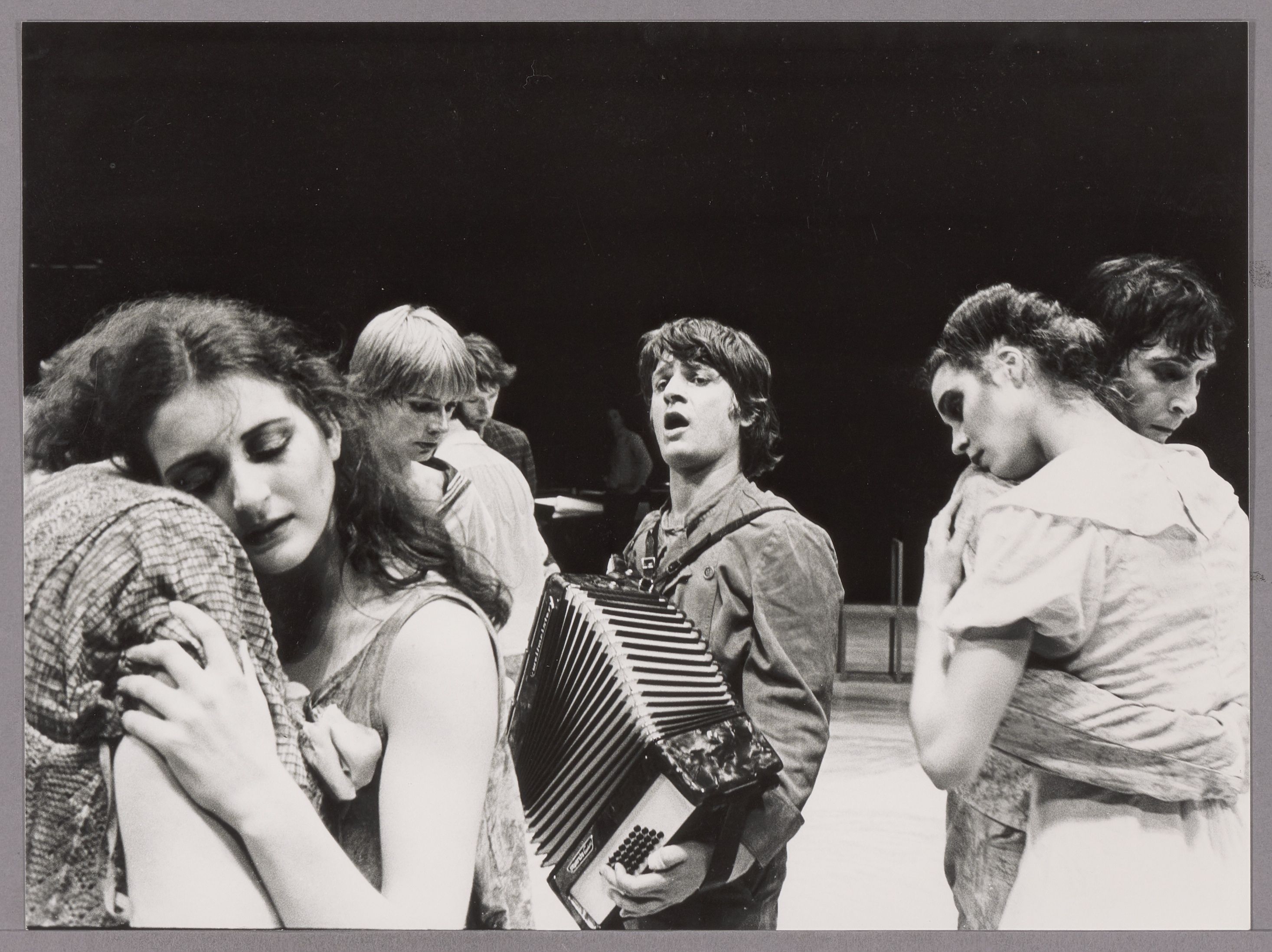
Production for small theatres in Bellevue
As an exception, Dutch National Ballet produces a programme for small theatres, presented in Theater Bellevue, in Amsterdam. For the programme, artistic director Rudi van Dantzig creates Ik hou gewoon m'n adem in, to music by Boudewijn Tarenskeen and De Gebroeders Flint.
83 / 84
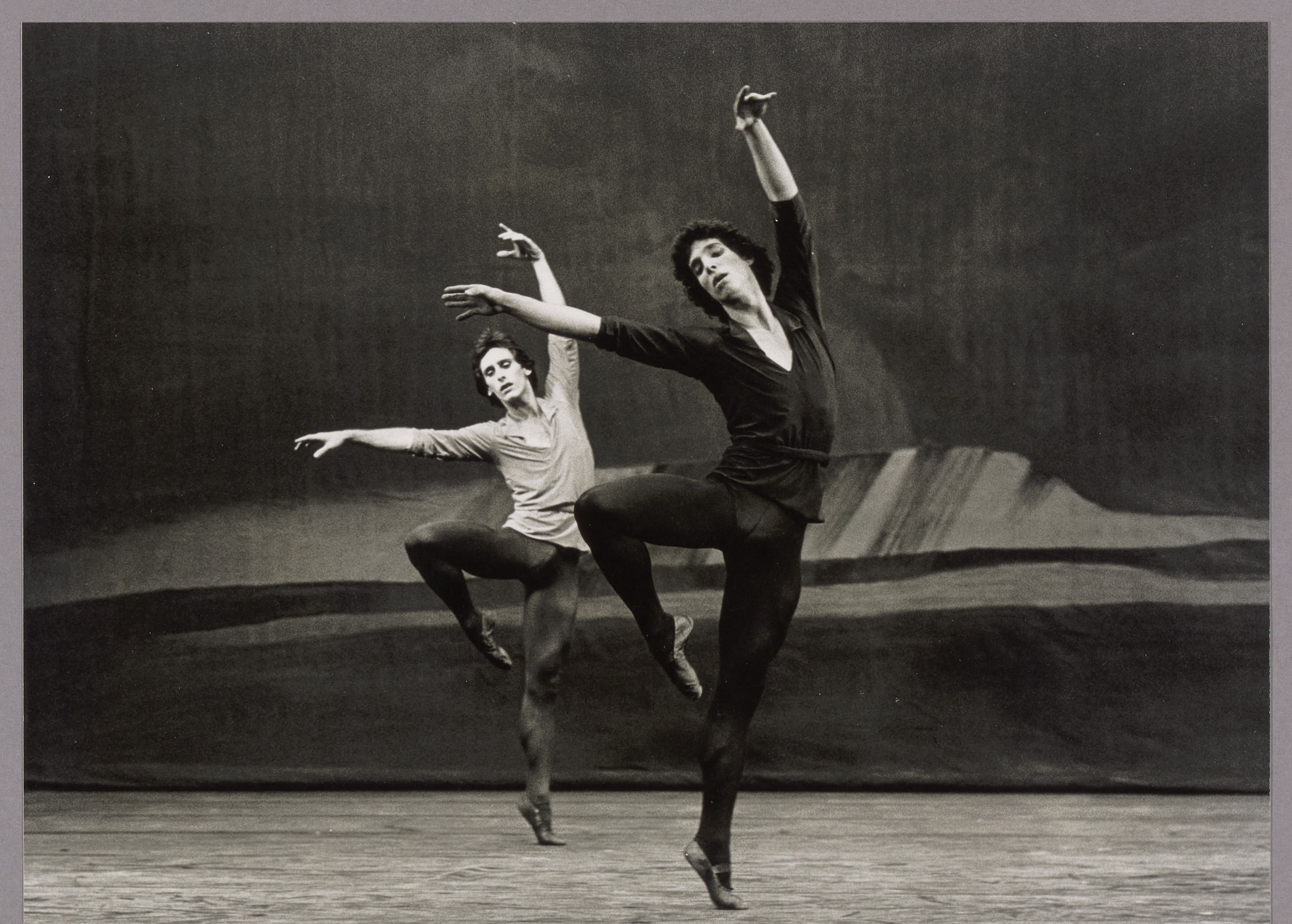
Golden Theatre Dance Prize for Clint Farha
Principal dancer Clint Farha receives the Golden Theatre Dance Prize from the VSCD, for his performances in Giselle (as Count Albrecht), Hans van Manen’s 5 Tangos and Sarcasmen, Rudi van Dantzig’s Four Last Songs and George Balanchine’s Prodigal Son.

Hans van Manen in Carré and London
A big crowd-puller this season is the Hans van Manen programme performed at Theater Carré, comprising In and Out, Adagio Hammerklavier and four of his five Pianovariaties: Sarcasmen, Trois gnossiennes, Pose and Portrait (the latter work is performed by guest dancer Pauline Daniëls, for whom Van Manen had created this solo a few months earlier).
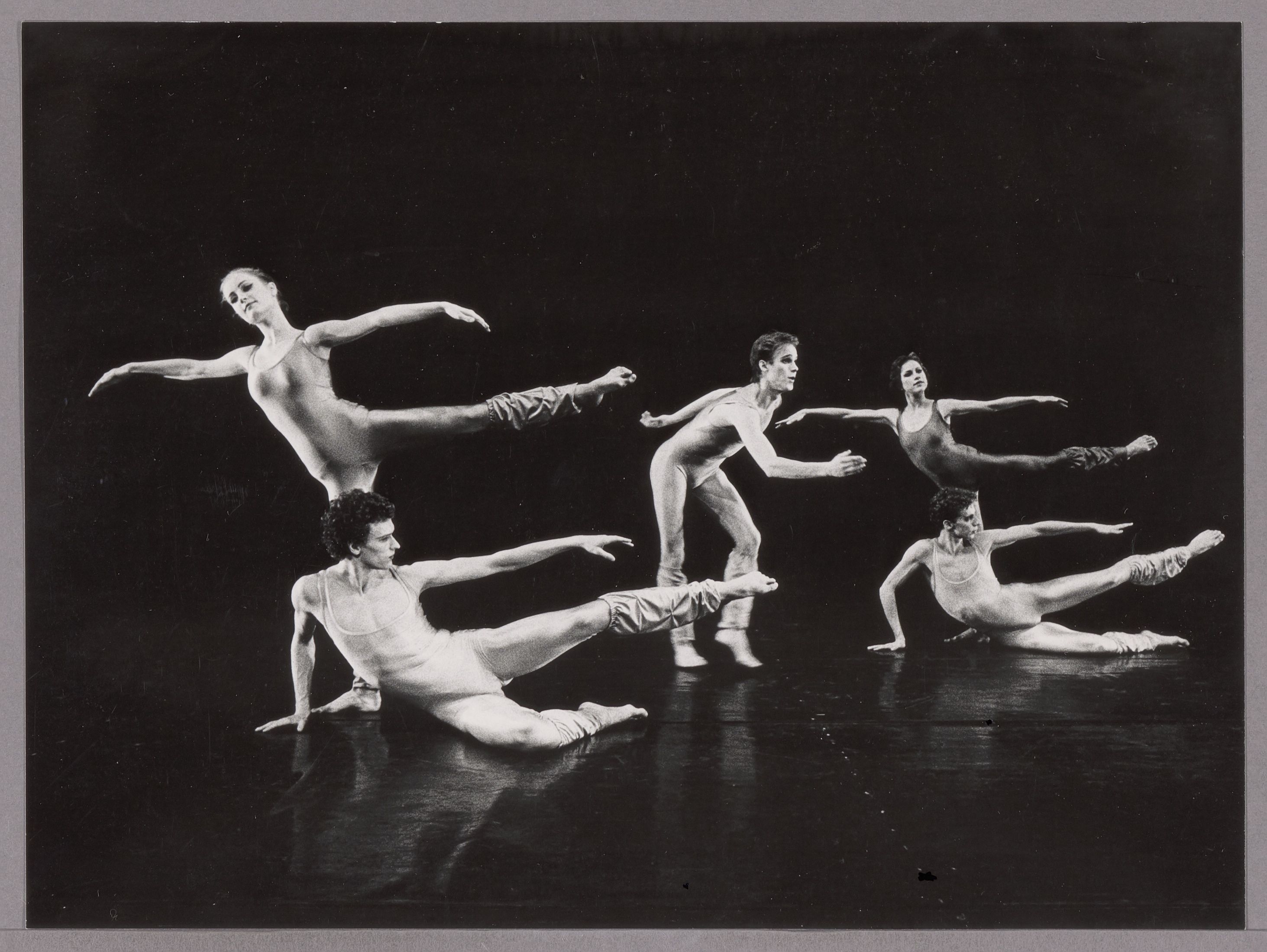
Controversial
Exceptional new additions to the repertoire this season are Rodin, by the Soviet Russian choreographer Leonid Jakobson, inspired by the sculptures of Auguste Rodin (the press calls the ballet “a historical curiosity”), and the minimalist, repetitive Slow, heavy and blue by the American post-modern choreographer Carolyn Carlson.
"Slow, heavy and blue is like one big trip", writes Het Vrije Volk.
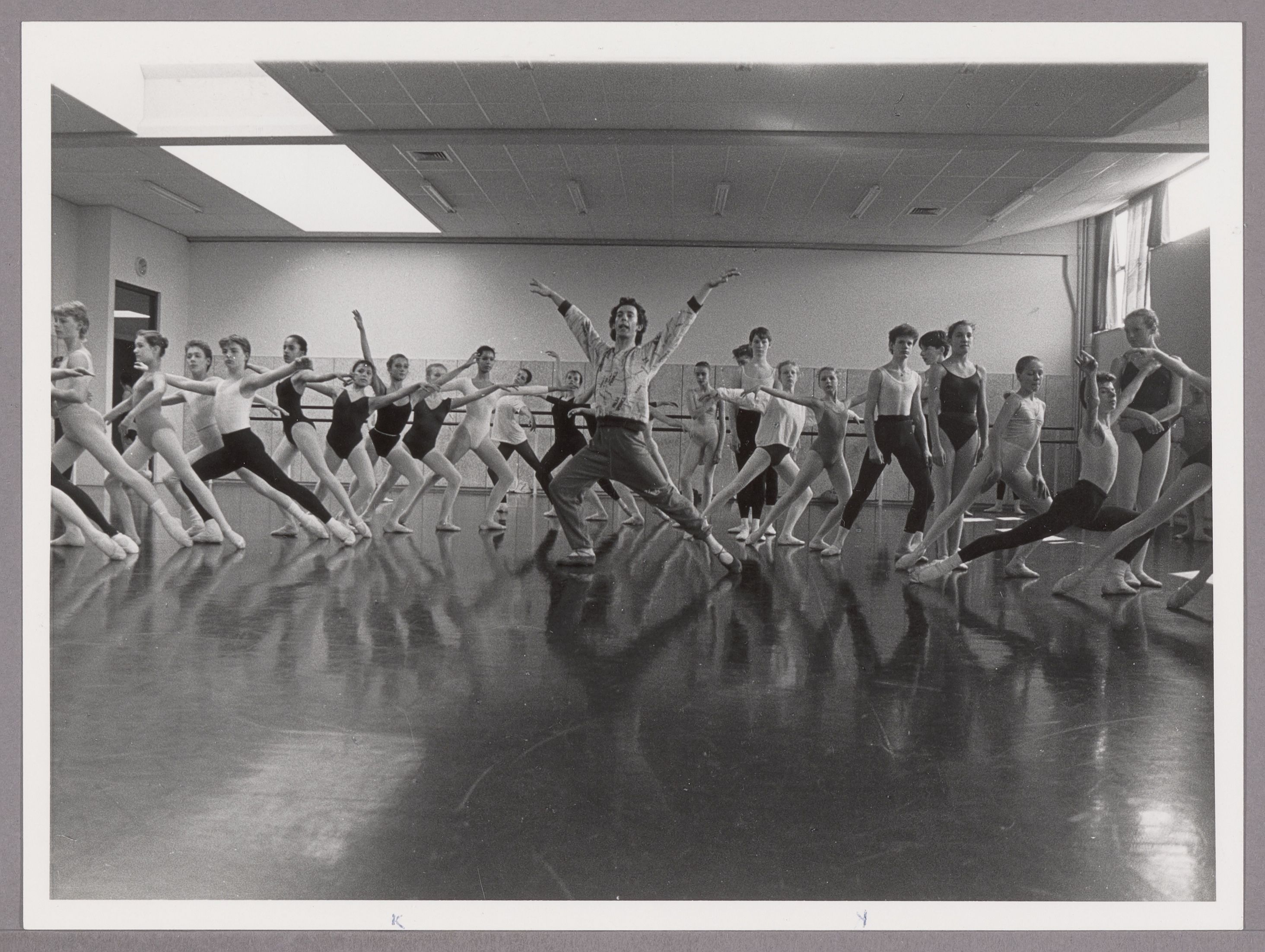
Partnership with the Nel Roos Academy
In January 1984, a partnership agreement is signed between Dutch National Ballet and the Nel Roos Academy of Ballet (part of the Amsterdam University of the Arts and one of the forerunners of the Dutch National Ballet Academy). From now on, pupils and students of the academy take part in Dutch National Ballet’s performances, and ballet masters and dancers from the company give classes at the academy.

Head of the artistic staff
Ballet master Reuven Voremberg is appointed head of the artistic staff. Voremberg, born in Israel, joined the Nederlands Ballet in 1958 and danced with Dutch National Ballet from 1961 to 1972. He then became assistant ballet master and ballet master respectively. Voremberg remains associated with the company until 2000, for the last two years in the position of artistic advisor.
84 / 85
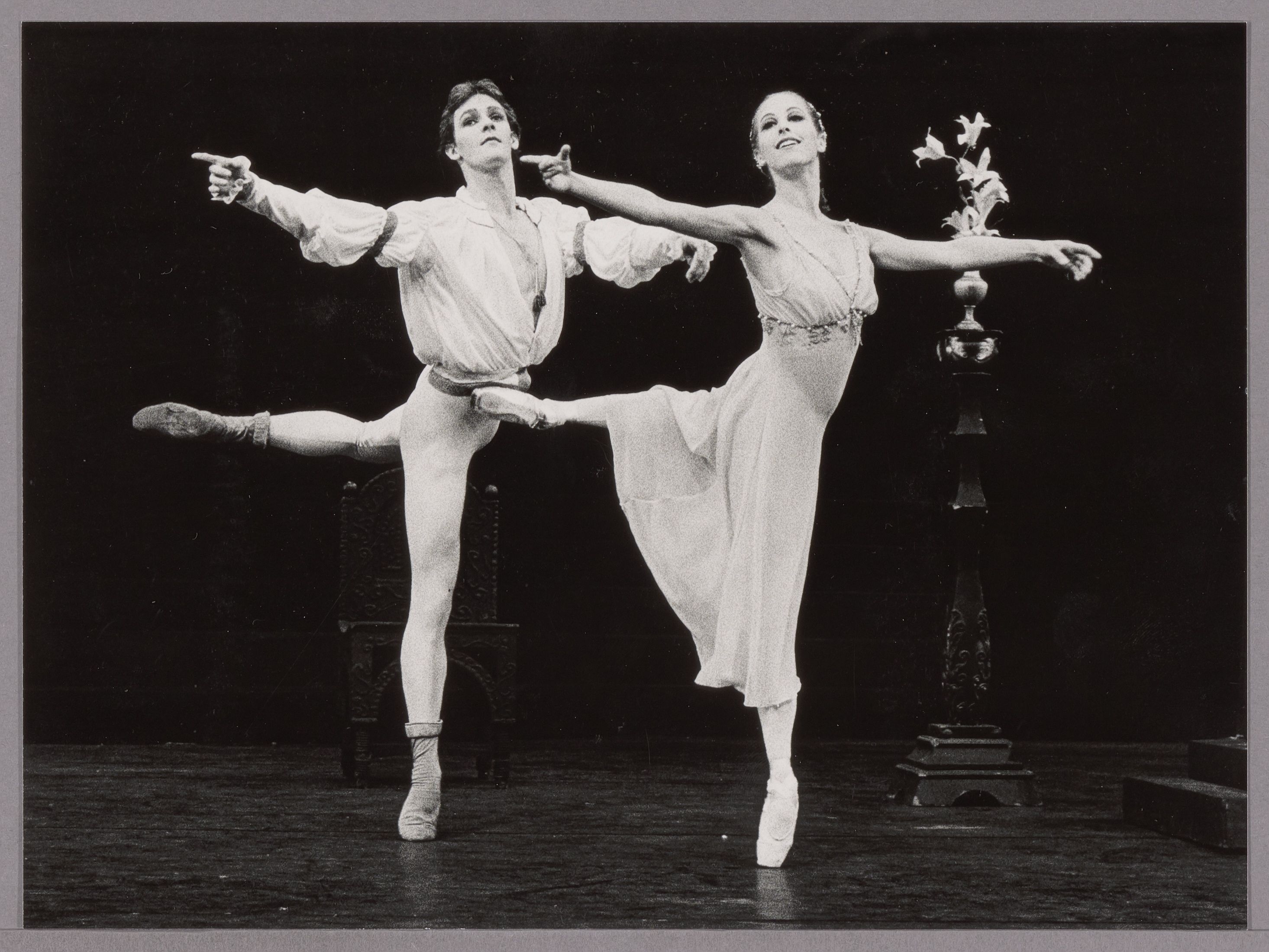
Romeo and Juliet in Carré
Dutch National Ballet achieves record figures (audiences of 19,915) with a series of performances of Rudi van Dantzig’s Romeo and Juliet, specially adapted for performance in the round at Theater Carré. The first night is danced by Alexandra Radius ("a phenomenal interpretation of Juliet") and Henny Jurriëns (“a balanced, mature, serious interpretation”). However, most of the attention this time is directed at the young couple Jane Lord – just recently promoted to soloist – and Barry Watt.
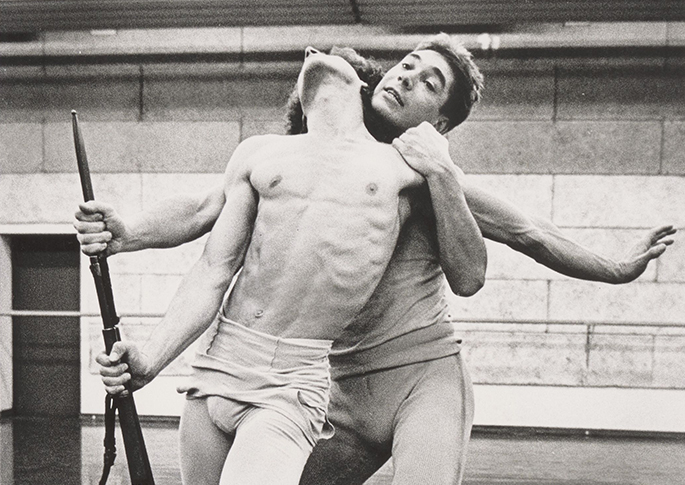
Want wij weten niet wat wij doen
Van Dantzig’s new, controversial ballet Want wij weten niet wat wij doen also draws great attention. The ballet includes a ‘Christ figure’, danced by Clint Farha, and a major role for the current artistic director Ted Brandsen as Adam, the first human. It sketches a bleak yet very impressive picture of how we humans deal with the world and one another.
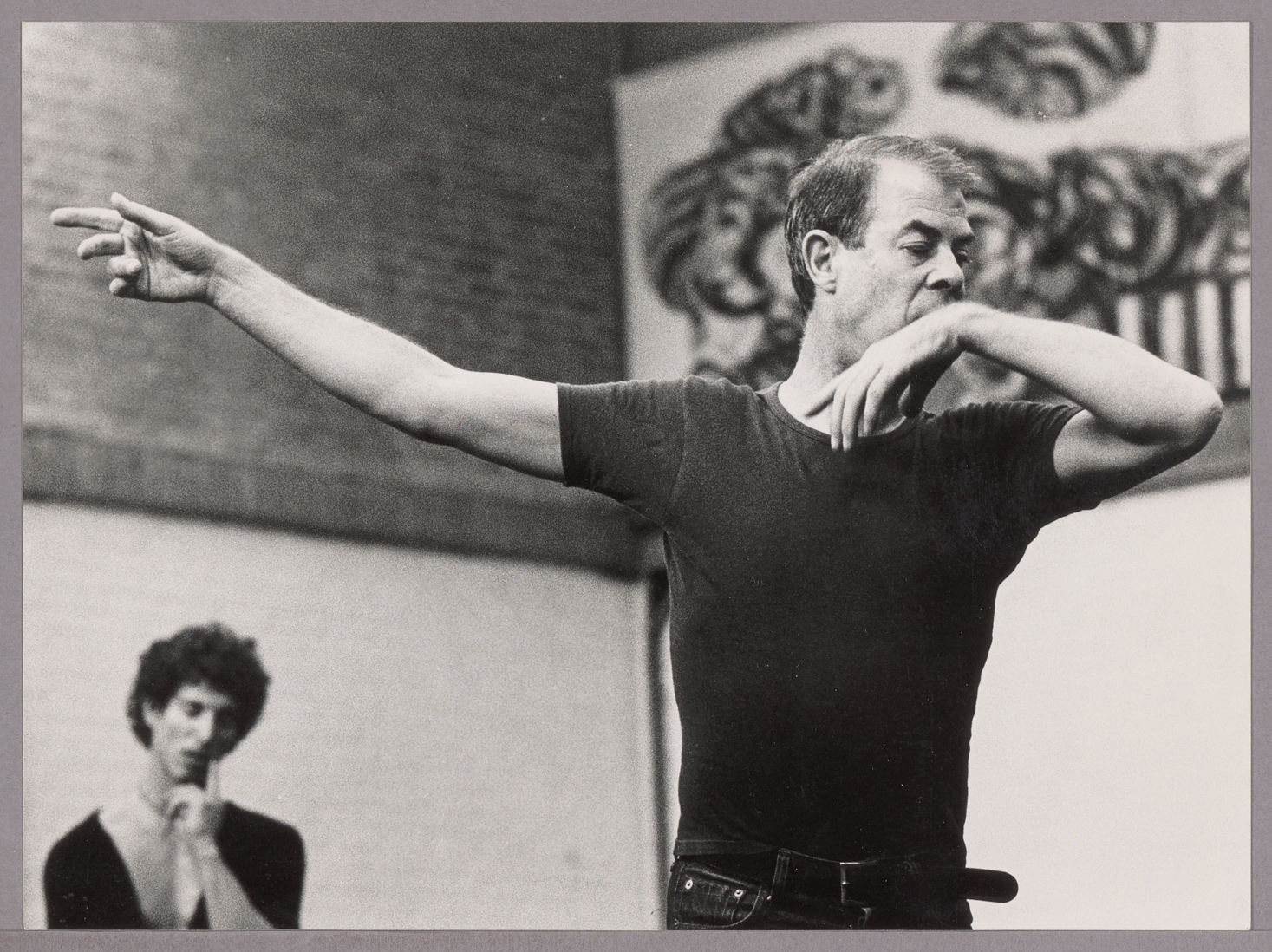
Choreography Prize for Hans van Manen
Hans van Manen is the first recipient of the new Choreography Prize, awarded by the VSCD.
The first 'block programmes'
Up to now Dutch National Ballet has alternated the repertoire per performance, but this is the first season it presents ‘block programmes’, which comprise a series of performances of the same ballet(s).
Directie Overleg Dansgezelschappen
Dutch National Ballet is one of the founders of ‘Directie Overleg Dansgezelschappen’ (DOD), a consultative body in which another eight Dutch dance companies are represented besides Dutch National Ballet.
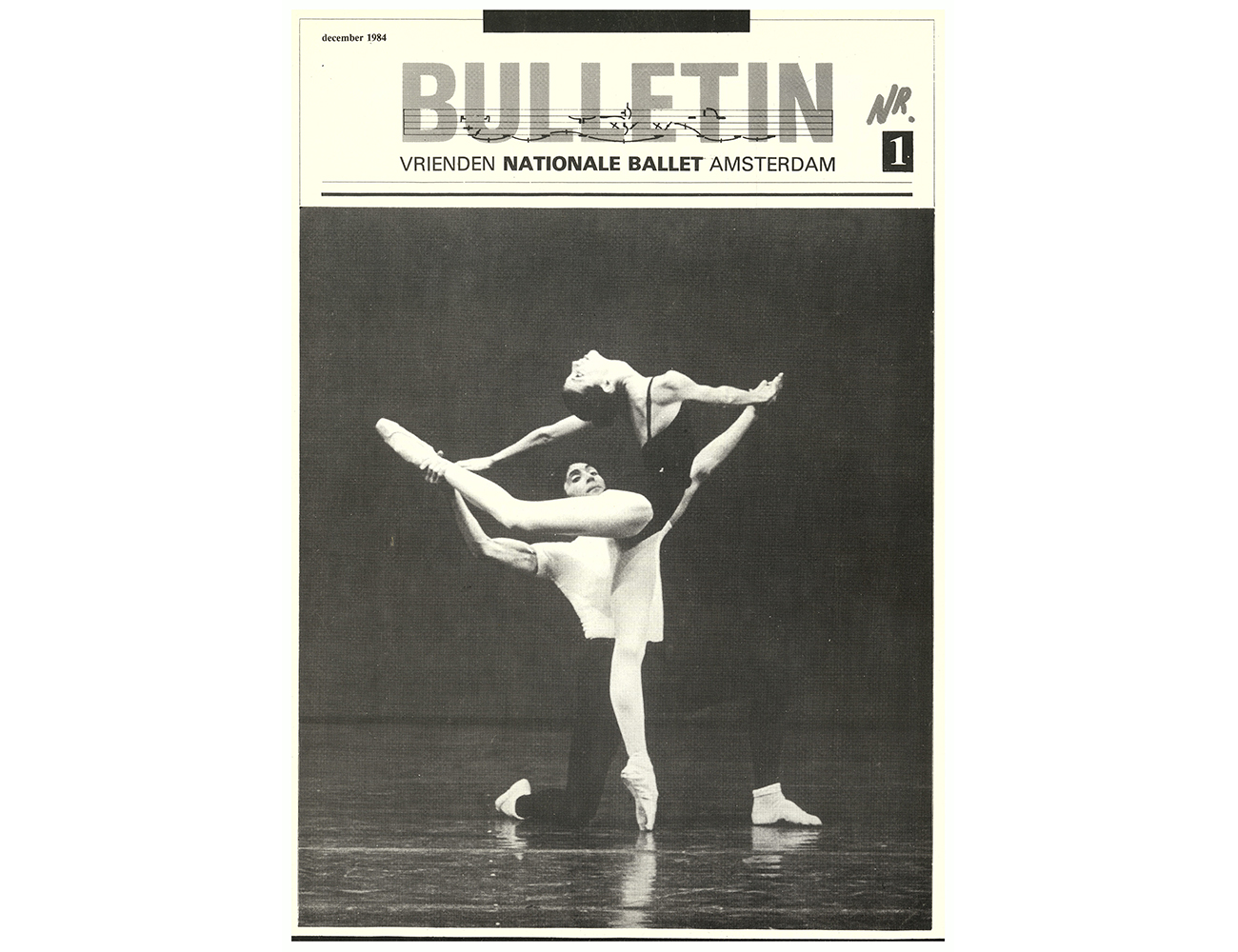
Friends of Dutch National Ballet
Fans of Dutch National Ballet had already set up their own Friends Association in The Hague, but this season Dutch National Ballet takes the initiative of setting up its own Friends of Dutch National Ballet Foundation. From now on, the foundation publishes its own magazine several times a year and organises numerous activities for new Friends, including meet and greets, open classes and rehearsals, guided tours and trips abroad to visit ballet Meccas.
85 / 86
Last season in the Stadsschouwburg
Dutch National Ballet’s 25th season is its last one in the Stadsschouwburg, in Amsterdam. On 3 April 1986, the company gives its last performance (for the time being) in the theatre, to which everyone who has worked with the company over the past 25 years is invited.
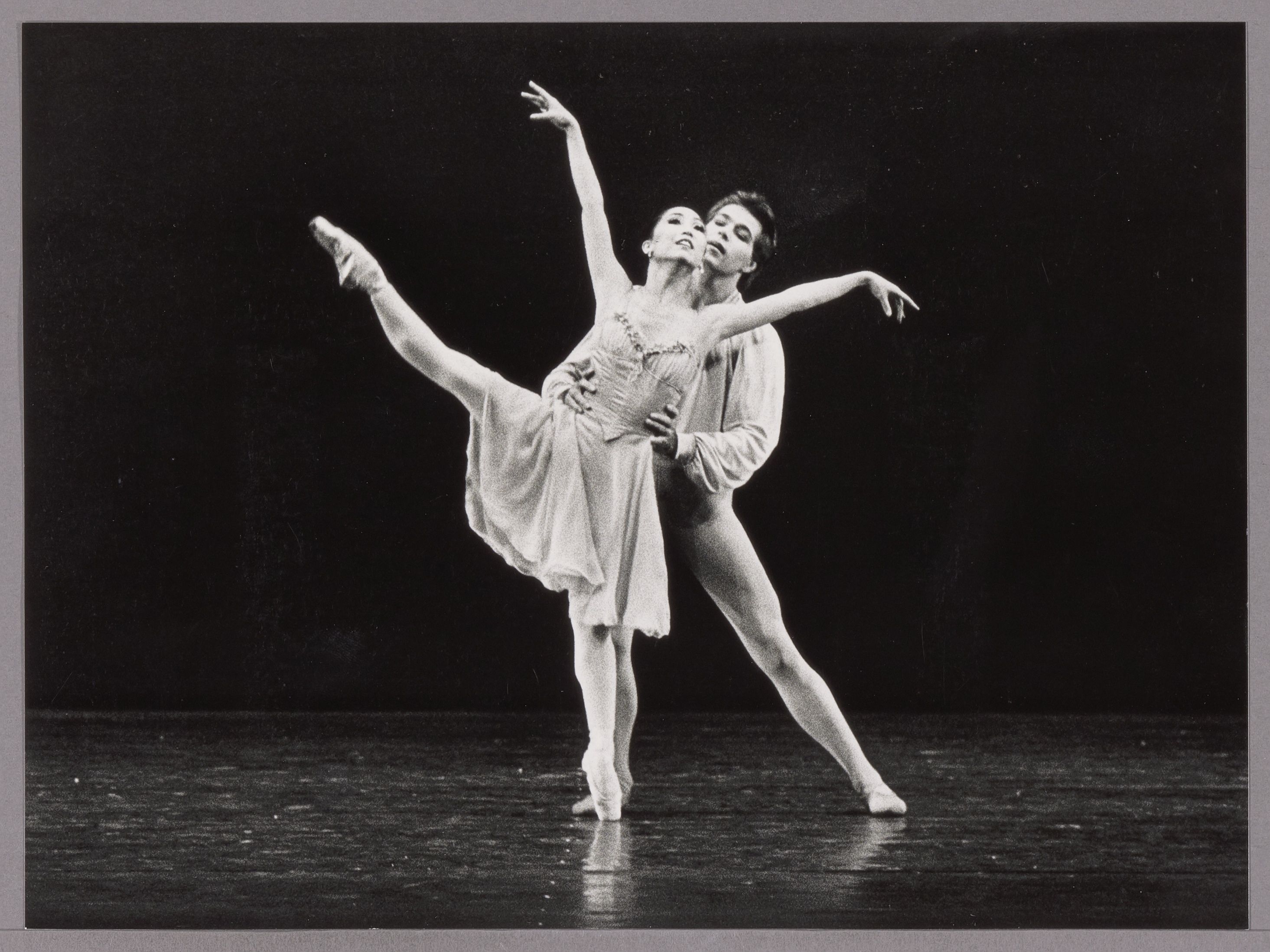
Twentieth Balanchine
Dutch National Ballet adds its 20th Balanchine ballet to the repertoire: Tchaikovsky Pas de Deux. “A duet like a fresh spring breeze; playful, spirited, brilliant and high-speed (..) excellently danced with great bravura by Caroline Iura and Fred Berlips”, writes NRC Handelsblad.
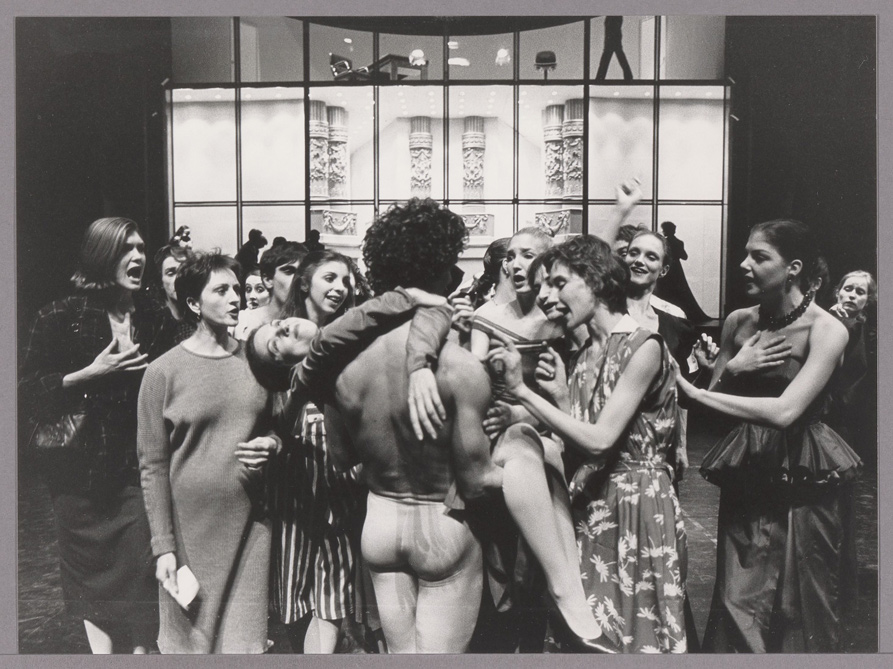
Bacchanten
With the ambitious Bacchanten, artistic director Rudi van Dantzig underlines his preference for experiment. For this production, he invites stage director Gerardjan Rijnders to come and create a large-scale, oppressive and totally unique adaptation of Euripides' famous satirical tragedy, along with composer Boudewijn Tarenskeen and dramaturge Janine Brogt, assisted by choreographer Ted Brandsen.
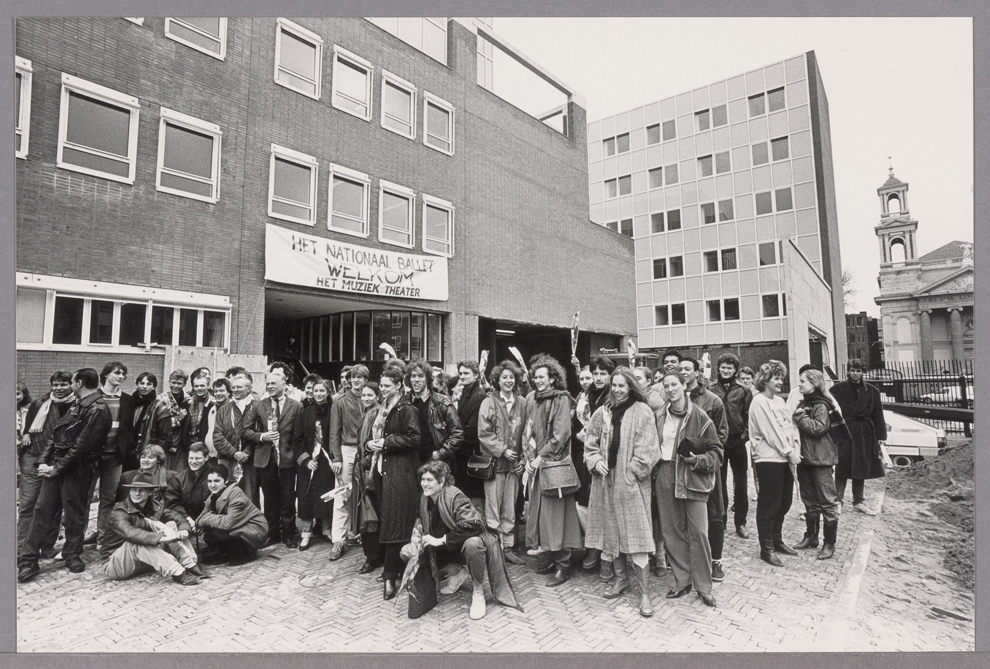
Moving to the Music Theatre
On 21 April, the company moves, along with De Nederlandse Opera (now Dutch National Opera) to the Music Theatre (now Dutch National Opera & Ballet) at Waterlooplein. Both companies then have a few months to prepare for the grand opening of the theatre in September 1986.
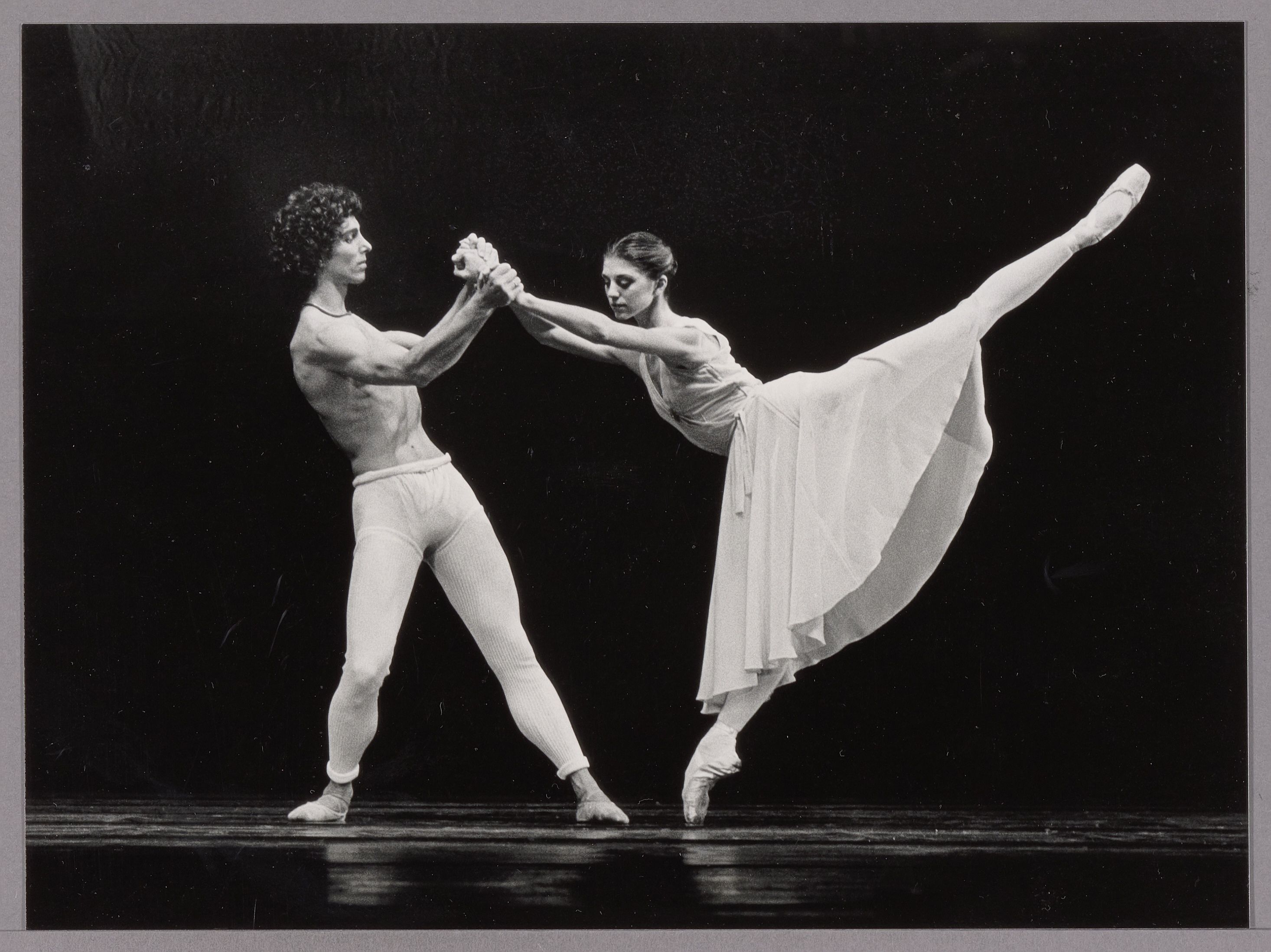
Golden Theatre Dance Prize for Coleen Davis
In May 1986, principal dancer Coleen Davis receives the Golden Theatre Dance Prize at the VSCD congress in Maastricht, which is presented to her by fellow dancer Alexandra Radius.
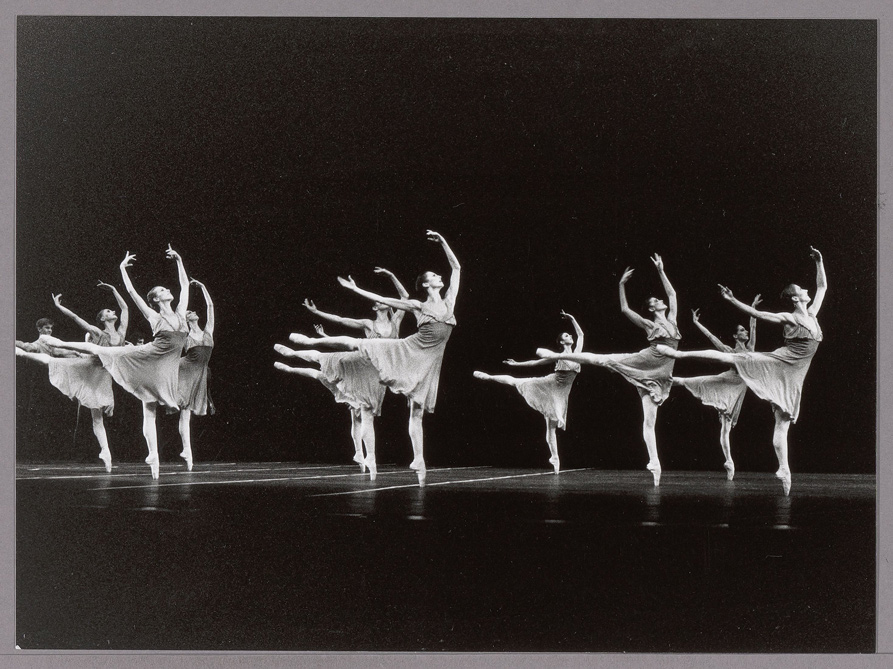
7th Symphony
On the occasion of leaving the Stadsschouwburg, Van Dantzig creates the male duet Afzien, for principals Han Ebbelaar and Francis Sinceretti. The latter is ending his dancing career with this performance. For the final Stadsschouwburg programme, Toer van Schayk creates his masterpiece 7th Symphony, which is awarded the VSCD Choreography Prize less than a year later. The ballet still receives standing ovations today.
86 / 87
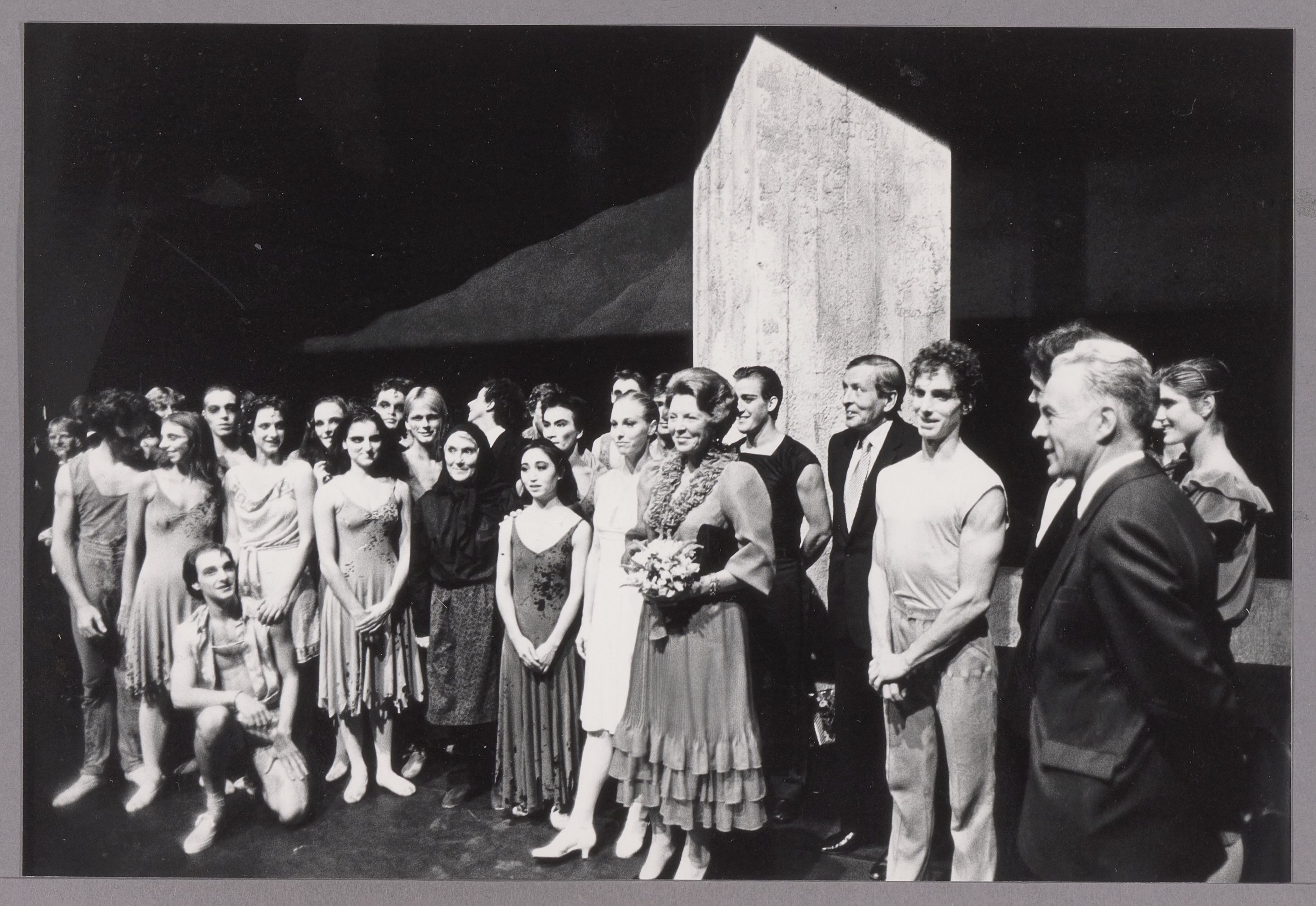
Opening of the Music Theatre
The official opening of the Music Theatre takes place on 23 September 1986, attended by Queen Beatrix, Prince Claus, 13 members of the Cabinet, the full board of the City of Amsterdam and many other invitees. The joint performance by Dutch National Ballet and Dutch National Opera is broadcast live on television by the NOS. In the following weeks, various extra opening performances are given for other groups of invitees.
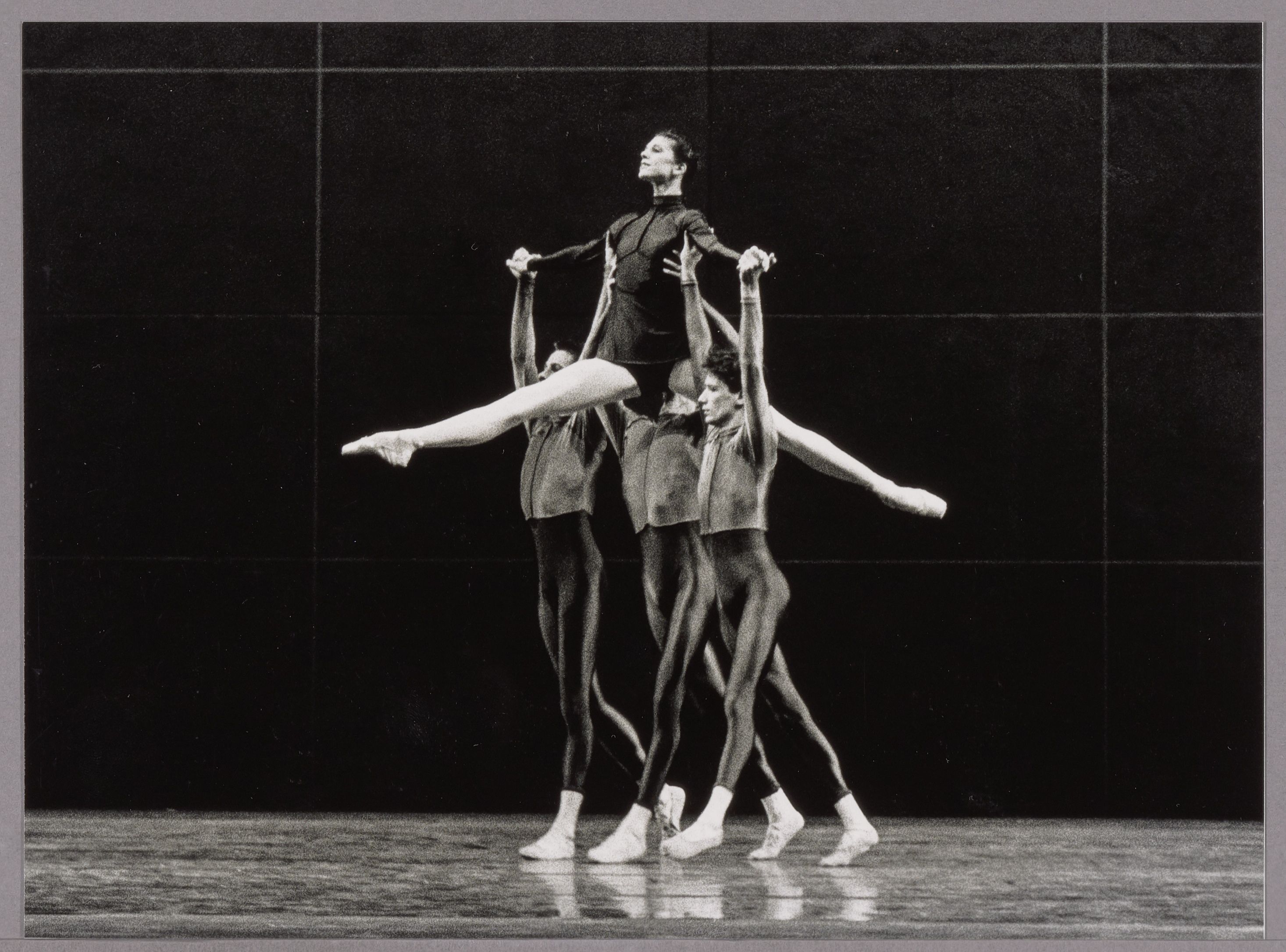
Zoals Orpheus and Opening
For the joint official opening performance, Toer van Schayk creates Zoals Orpheus, which forms a double bill with Otto Ketting’s Ithaka, presented by De Nederlandse Opera. Two days later, Dutch National Ballet presents its own opening programme, comprising a new work by Hans van Manen, Opening, and revivals of 7th Symphony by Van Schayk and Collective Symphony by Van Dantzig, Van Manen and Van Schayk.
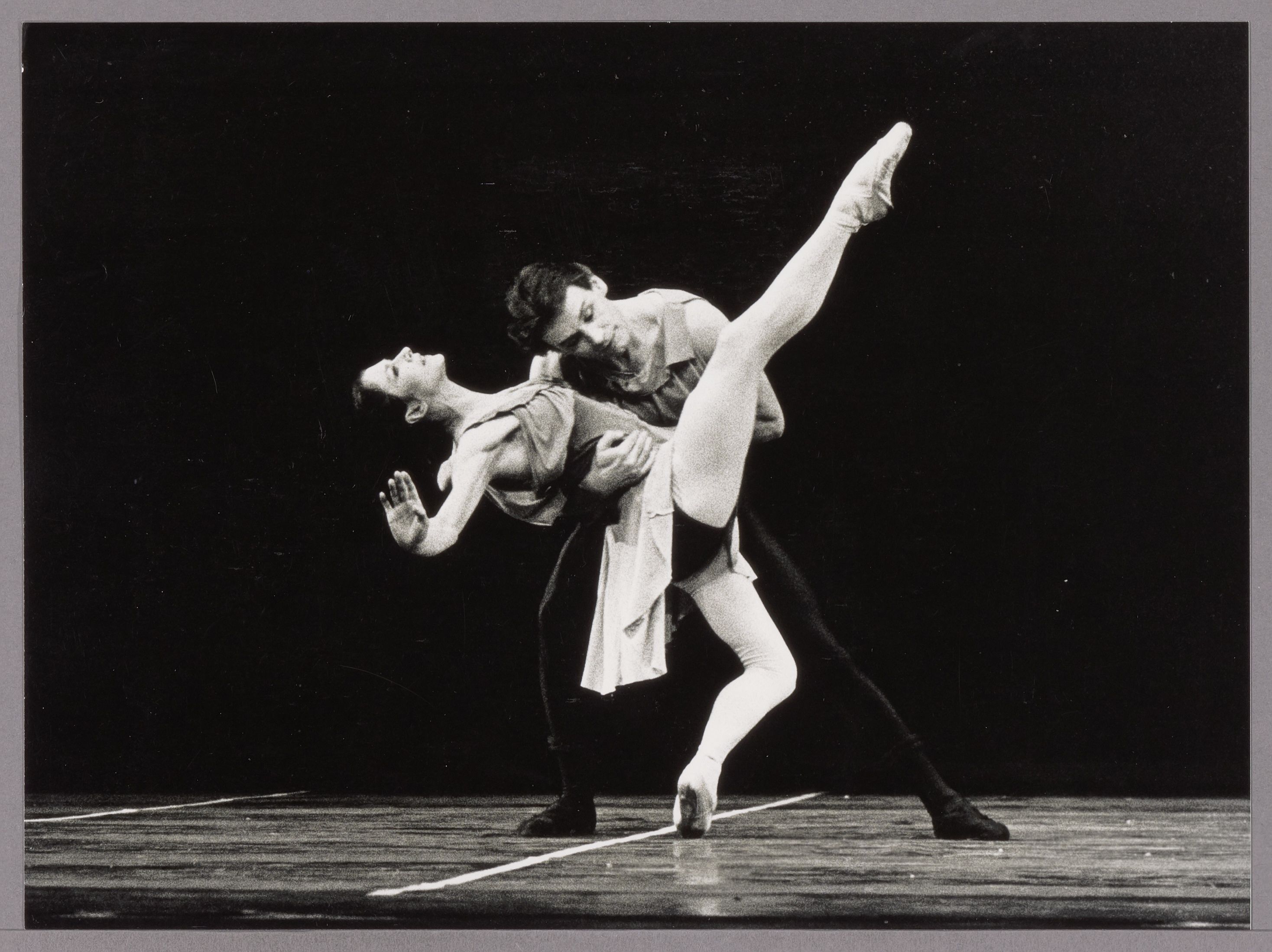
Farewell performance for Han Ebbelaar
On 12 October 1986, principal dancer Han Ebbelaar ends his dancing career with Dutch National Ballet. For the occasion, he dances Hans van Manen’s Twilight – partnering his wife Alexandra Radius – and Toer van Schayk’s 7th Symphony. However, he keeps performing with Radius in the couple’s own dance programmes until May 1988. From the 1987/1989 season, Ebbelaar spends two years as associate artistic director of the company.
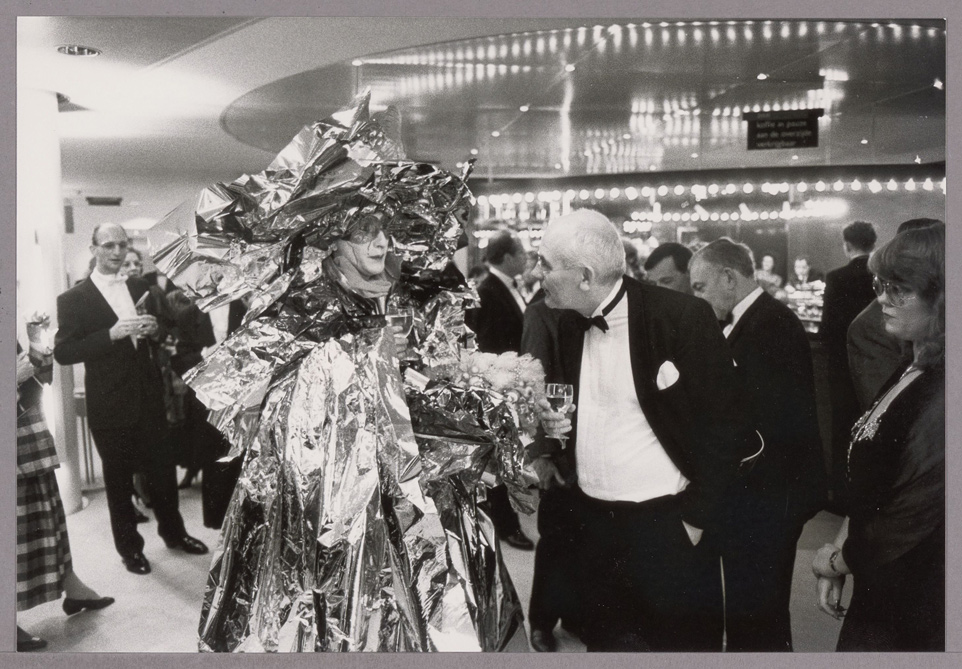
First New Year Gala
To close the 25th anniversary celebrations, Dutch National Ballet organises its first New Year Gala on 1 January 1987. The occasion also marks the presentation of the book 25 Years of Dutch National Ballet, compiled by Luuk Utrecht, Caroline Willems and Astrid van Leeuwen.
The photo shows 'living artwork' Fabiola, who is in flamboyant attendance at the first New Year Gala.
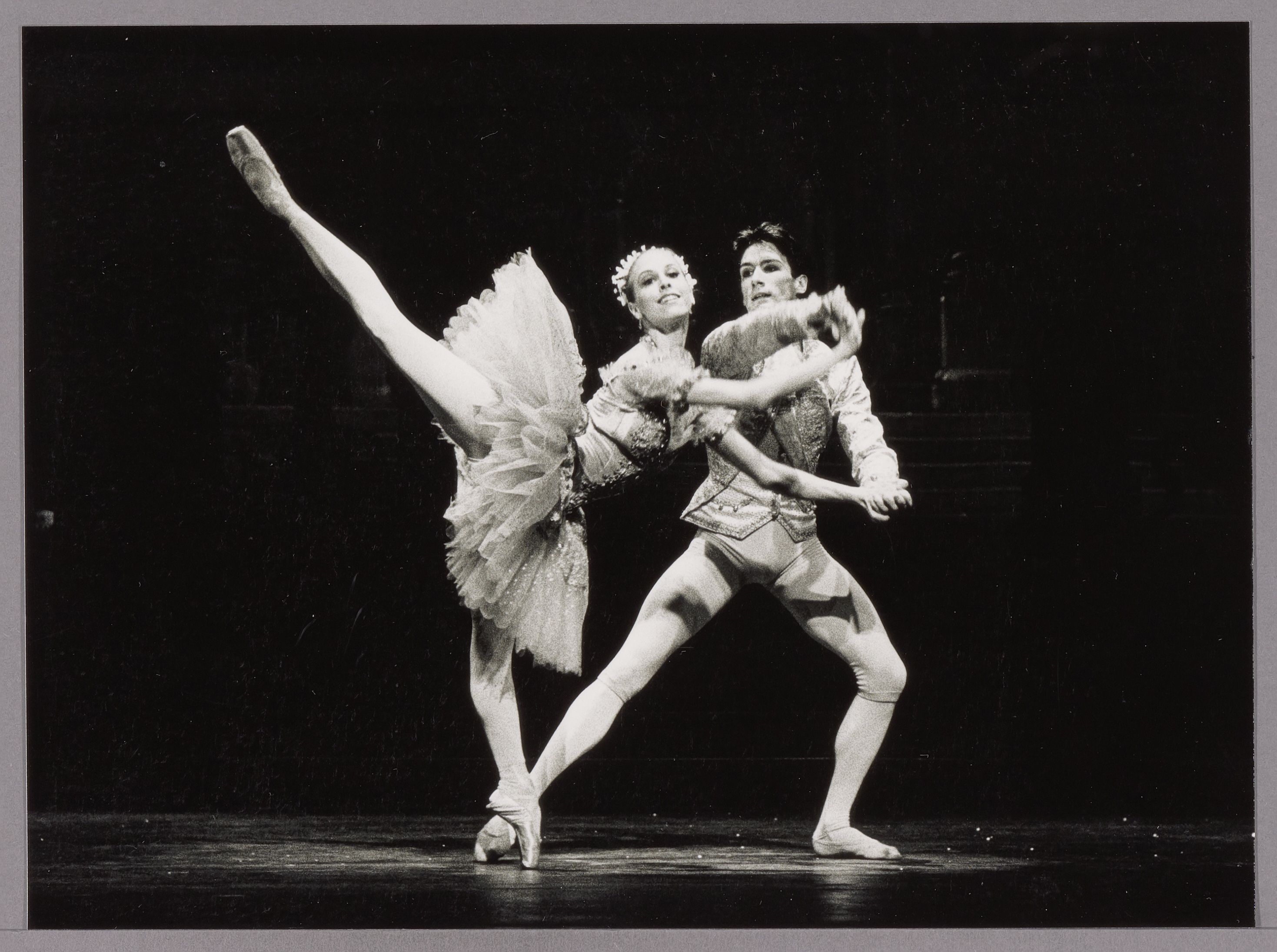
Cinderella
In April 1987, the company takes Frederick Ashton’s full-length Cinderella into the repertoire, set to the composition of the same name by Sergei Prokofiev, with sets and costumes by David Walker. The ballet quickly becomes one of Dutch National Ballet’s big audience favourites. At the premiere, the main roles are danced by soloists Jane Lord and Wim Broeckx, who at the time are actually in love in real life, which lends extra magic to their performance. “A delightful ballet classic”, in the view of Het Parool.

Amsterdam Cultural Capital of Europe
On 18 May 1987, Dutch National Ballet takes part in the opening event of Amsterdam Cultural Capital of Europe 1987. In Theater Carré, Hans van Manen’s iconic video ballet Live is presented, attended by Queen Beatrix, Prince Claus and the Ministers of Culture from various European countries. At the same time, the audience in the Music Theatre can see the ballet on a large video wall through a digital connection. Afterwards, Van Manen’s ballets Corps and Symphonieën der Nederlanden will be danced in the Music Theatre.
Departure of Hans van Manen
After 15 years as resident choreographer with Dutch National Ballet, Hans van Manen leaves the company, dissatisfied with the limited scope offered to him at the time in the programming. Before leaving, he presents one more premiere work: Symphonieën der Nederlanden (see repertoire). From 1988 to 2003, Van Manen is resident choreographer with Nederlands Dans Theater, after which he returns to Dutch National Ballet in the same position in 2005.
87 / 88

Guest programming at the Music Theatre
The opening of the Music Theatre also sees the foundation of the Guest Programming department, under the inspirational leadership of director Pieter Hofman, bringing ballet, opera and music theatre productions from all over the world to Amsterdam, between 1987 and 2009. The ball is set rolling by the famous Bolshoi Ballet from Moscow, which gives performances of the full-length ballets Raymonda and The Golden Age.
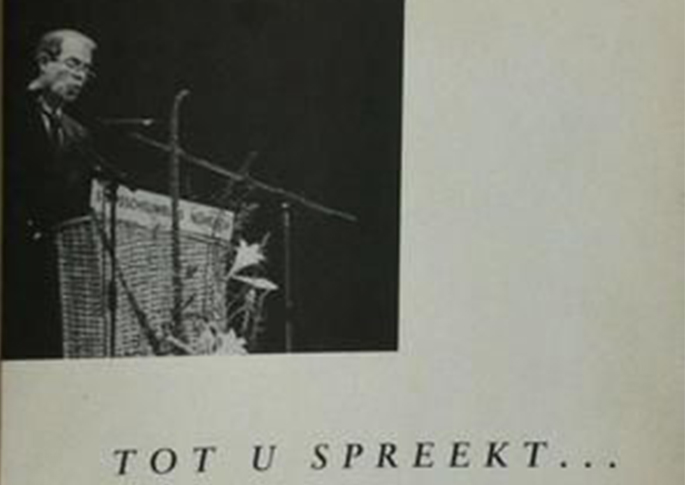
Inaugural address by Hans van Manen
On 1 November 1987, Hans van Manen gives his inaugural address as endowed professor at the Catholic Univeristy of Nijmegen. For the occasion, Dutch National Ballet performs his ballets Sarcasmen and Twilight.
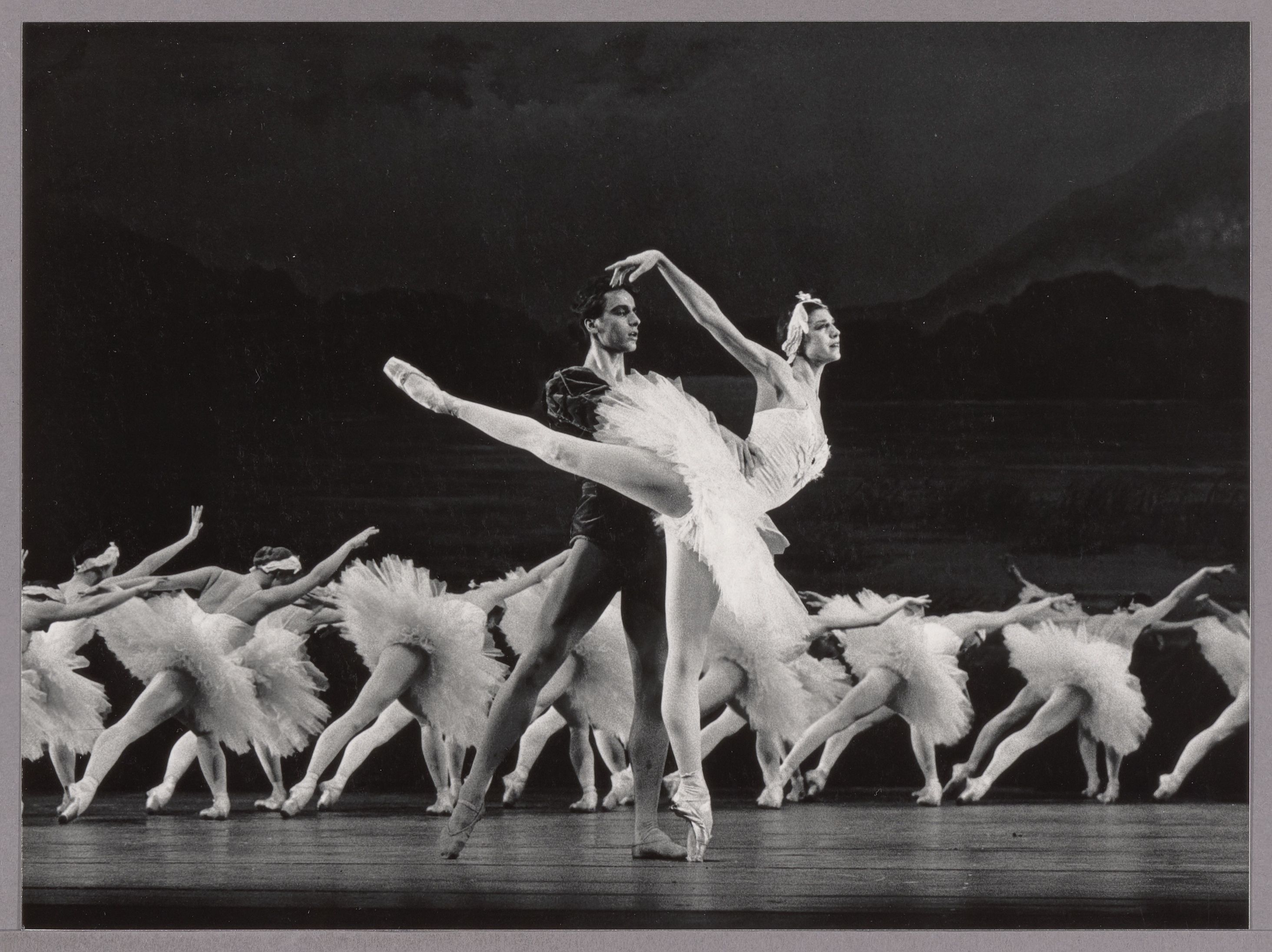
First completely Dutch Swan Lake
The first completely Dutch Swan Lake, with choreography by Rudi van Dantzig and sets and costumes by Toer van Schayk (who also choreographs the Act 3 character dances) premieres on 31 March 1988. Despite initially mixed press reviews, the production soon comes to be regarded as one of the important milestones in Dutch dance history. The headline in De Volkskrant reads, “Van Dantzig’s Swan Lake is the most beautiful to date”.
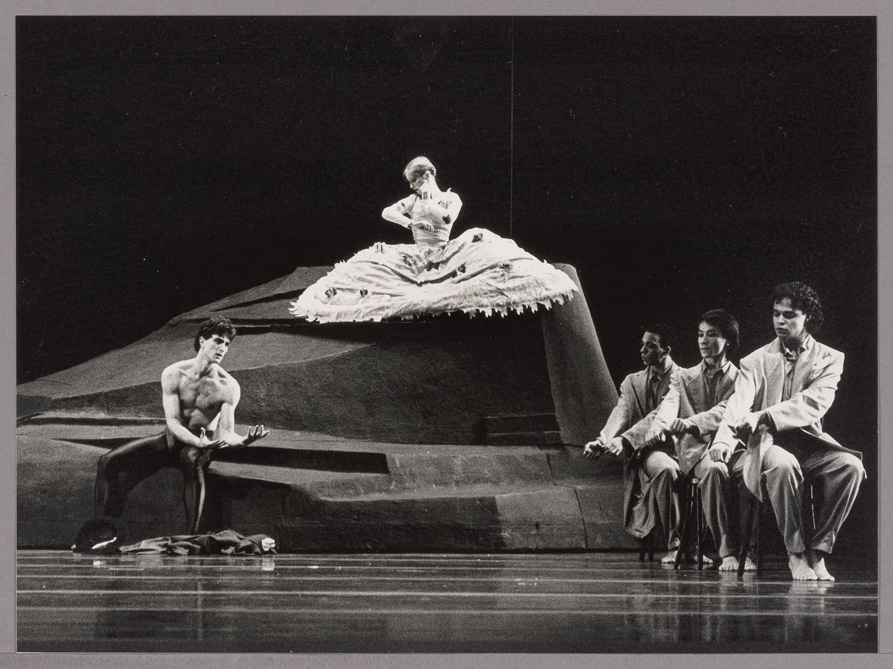
Shamrock
The American modern choreographer Carolyn Carlson, who works in Paris, creates Shamrock, a full-length work for 34 dancers of Dutch National Ballet, to specially written music by the famous film composer Gabriel Yared. NRC Handelsblad describes the production as having, “a very subtle, clear movement style, an often poetic and almost fragile atmosphere and a marvellous power of expression in surrealist images and situations”.
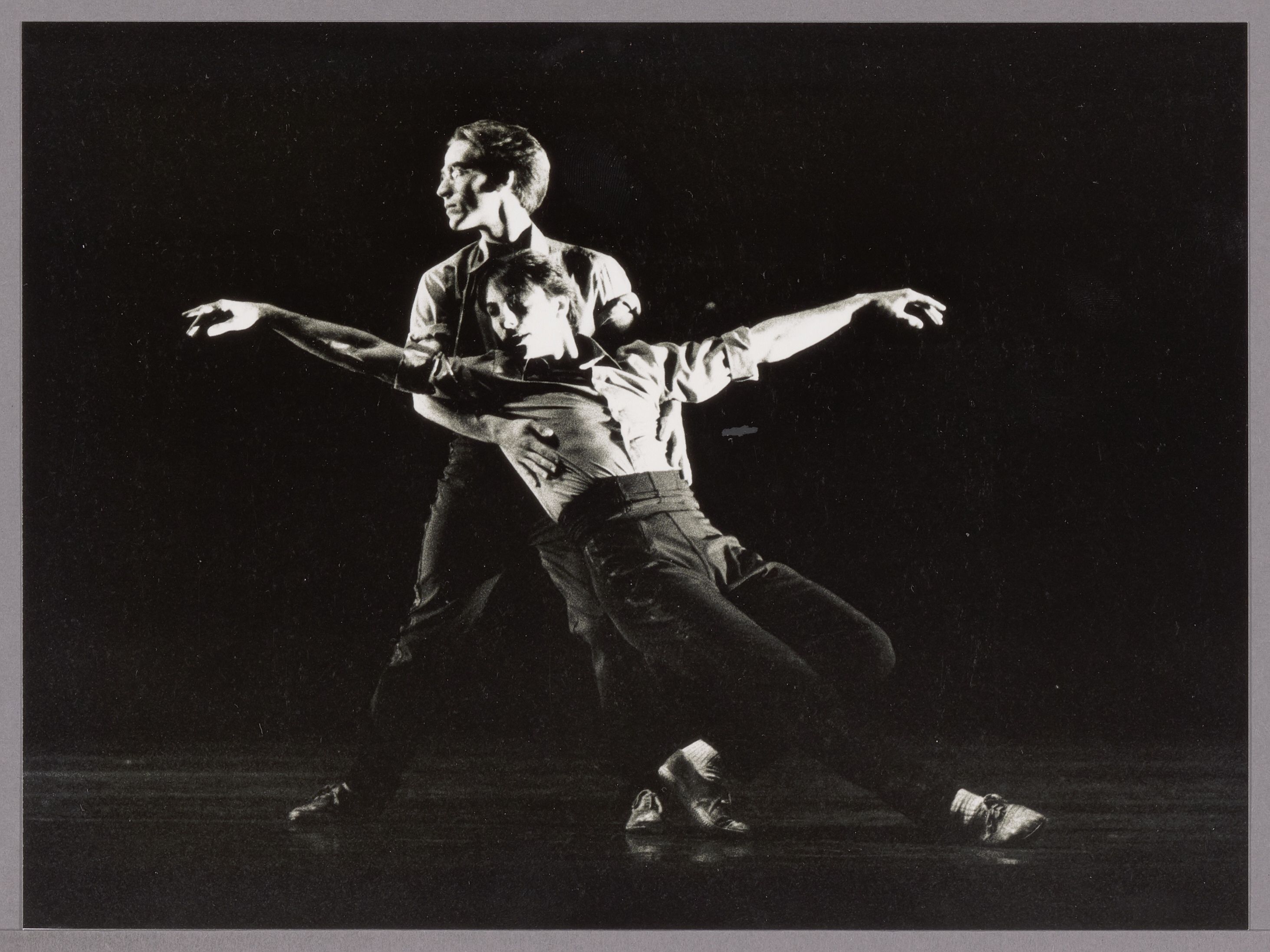
Bread Dances
Another striking premiere this season is Bread Dances by Édouard Lock, the figurehead of the newest dance sensation in Canada at the time: the distinctive LaLaLa Human Steps. "A sublime ballet (..) The sharpness, precision and capriciousness of the dancing borders on the incredible”, writes Trouw.

Alexandra Radius appointed Officer
On the occasion of her 30th dance anniversary, principal dancer Alexandra Radius is appointed Officer of the Order of Orange-Nassau.
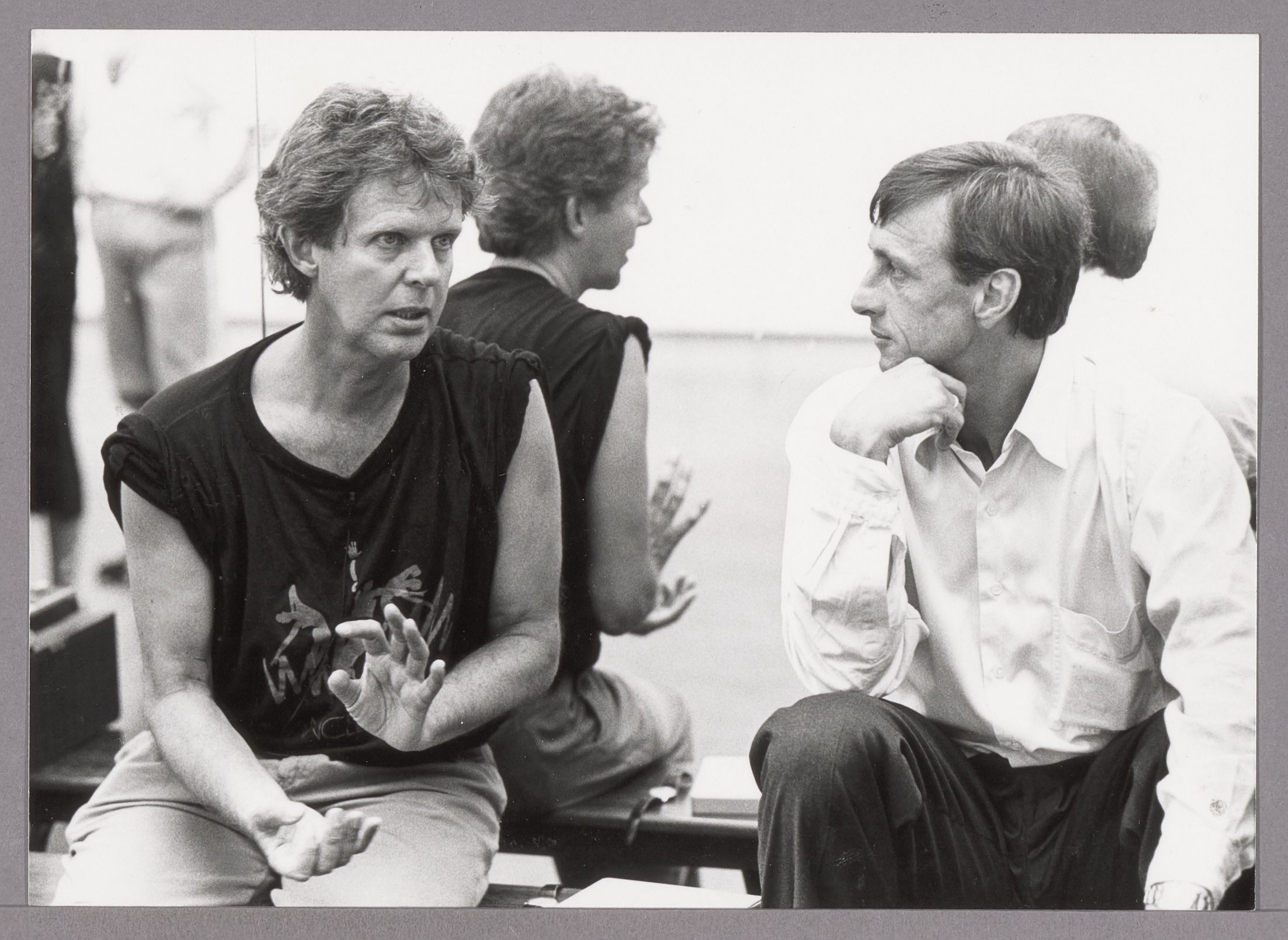
Schijnbewegingen
In a special NOS television documentary, Schijnbewegingen (Feints), director Piet Erkelens draws a comparison between dance and football. In the documentary, the Ajax football team is represented by Johan Cruijff and Marco van Basten, and Dutch National Ballet by Rudi van Dantzig and Clint Farha. During the filming period, Cruijff also visits some rehearsals and performances by Dutch National Ballet, whereby he remarks that “dancers work much harder than footballers”.
88 / 89
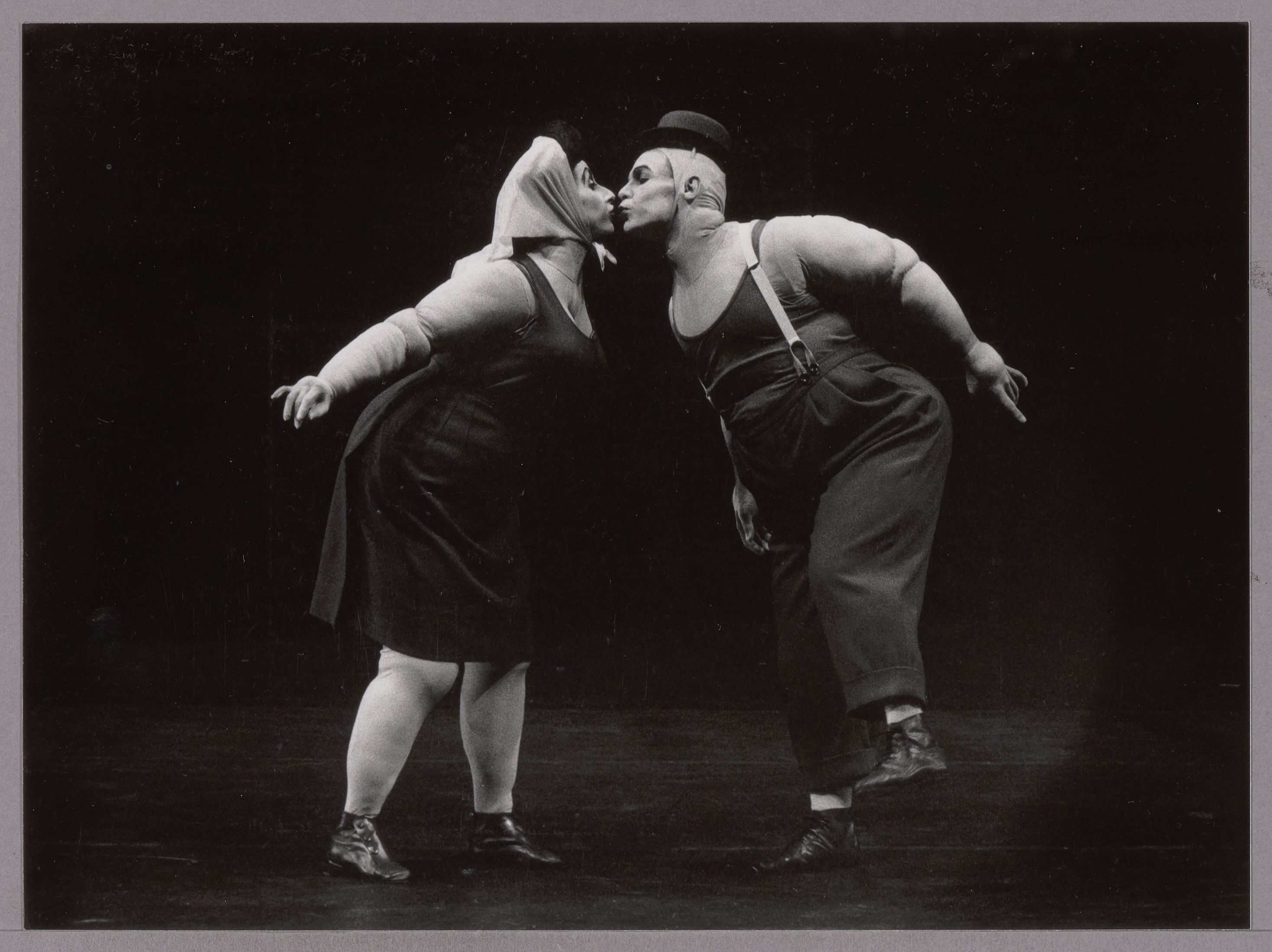
Groosland
An audience favourite right from the start is Maguy Marin’s Groosland, also known as the ‘fatties ballet’, due to the costumes by Casanova, which make the dancers appear naked and grossly overweight. “A delightful, cleverly constructed work with a candid playfulness seldom seen in dance any more”, writes NRC Handelsblad.
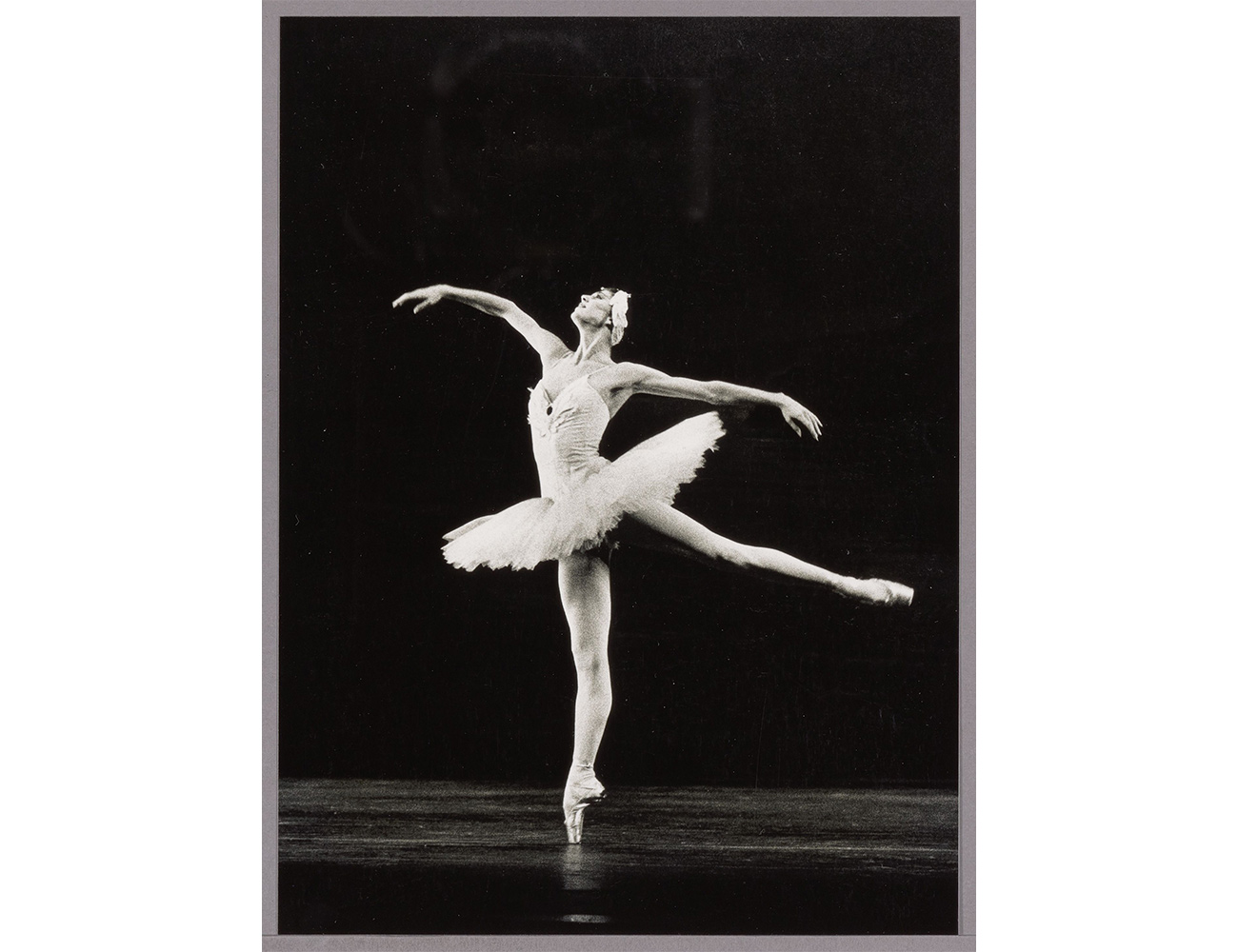
Shower of prizes
At the annual VSCD Theatre Gala, former principal dancer Han Ebbelaar receives the Golden Theatre Dance Prize. The VSCD Choreography Prize goes to Rudi van Dantzig, in honour of his Swan Lake. At the Dutch National Ballet’s New Year Gala, on 1 January 1989, dancer Coleen Davis receives the first Alexandra Radius Prize from the Friends of Dutch National Ballet Foundation.
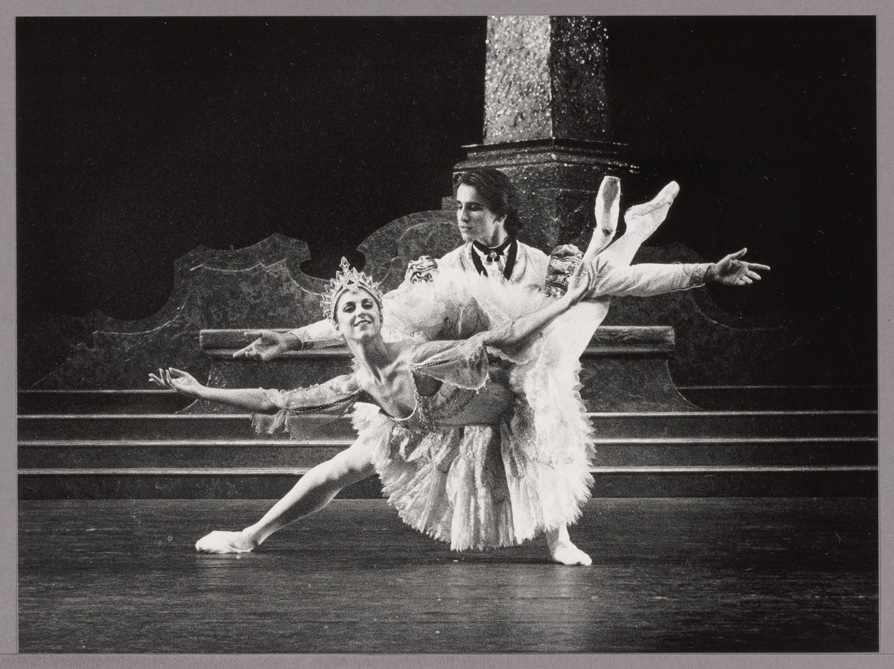
Sleeping Beauty in the Music Theatre for the first time
In March 1989, Sir Peter Wright’s The Sleeping Beauty has its first performance in the Music Theatre (now Dutch National Opera & Ballet). The choreographer and the designer Philip Prowse adapt their 1981 production for the much larger stage dimensions of the new theatre.
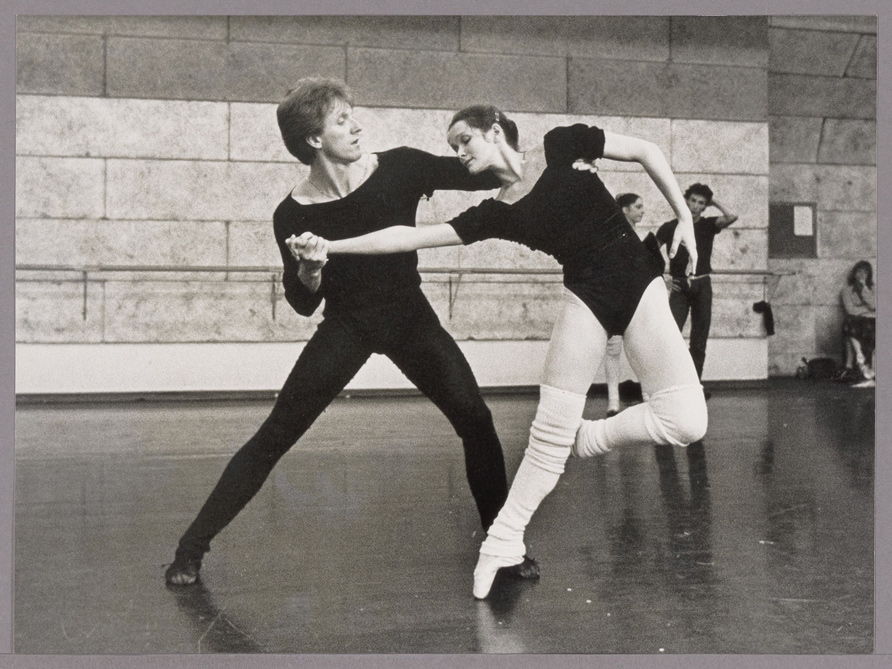
Henny Jurriëns and Judith James
On 9 April 1989, former principal dancer Henny Jurriëns and former soloist Judith James are killed in a car crash in Canada, where they have lived since 1986. Their three-year-old daughter Isa survives the accident. The news devastates the Dutch dance world. On 4 May 1989, Dutch National Ballet holds a commemorative event for the couple, at the Stadsschouwburg, in Amsterdam.
Taiwan and Canada
Dutch National Ballet gives its first performances in Taiwan. Five performances of Sir Peter Wright’s Giselle are given in the capital city Taipei. The company also provides the ‘reciprocal entertainment’ during a state visit to Canada by Queen Beatrix and Prince Claus, performing Van Manen’s Adagio Hammerklavier and Van Dantzig’s Four Last Songs.
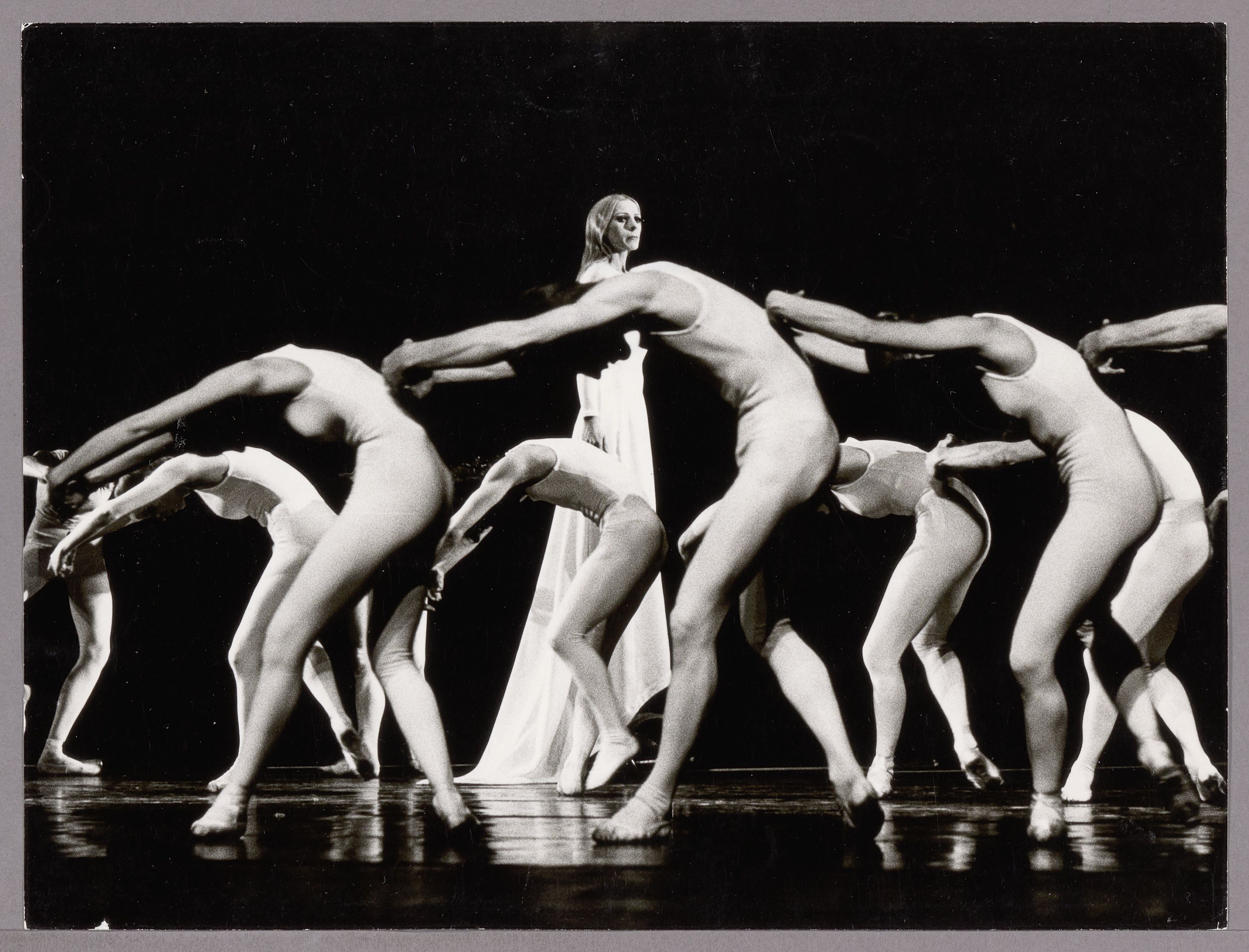
Dutch National Ballet Academy
In 1988, following a merger between the Nel Roos Academy for Ballet and the Scapino Dance Academy, in 1987, the merged Classical Ballet School is rechristened the Dutch National Ballet Academy, with Erna Droog as its first artistic director.
89 / 90
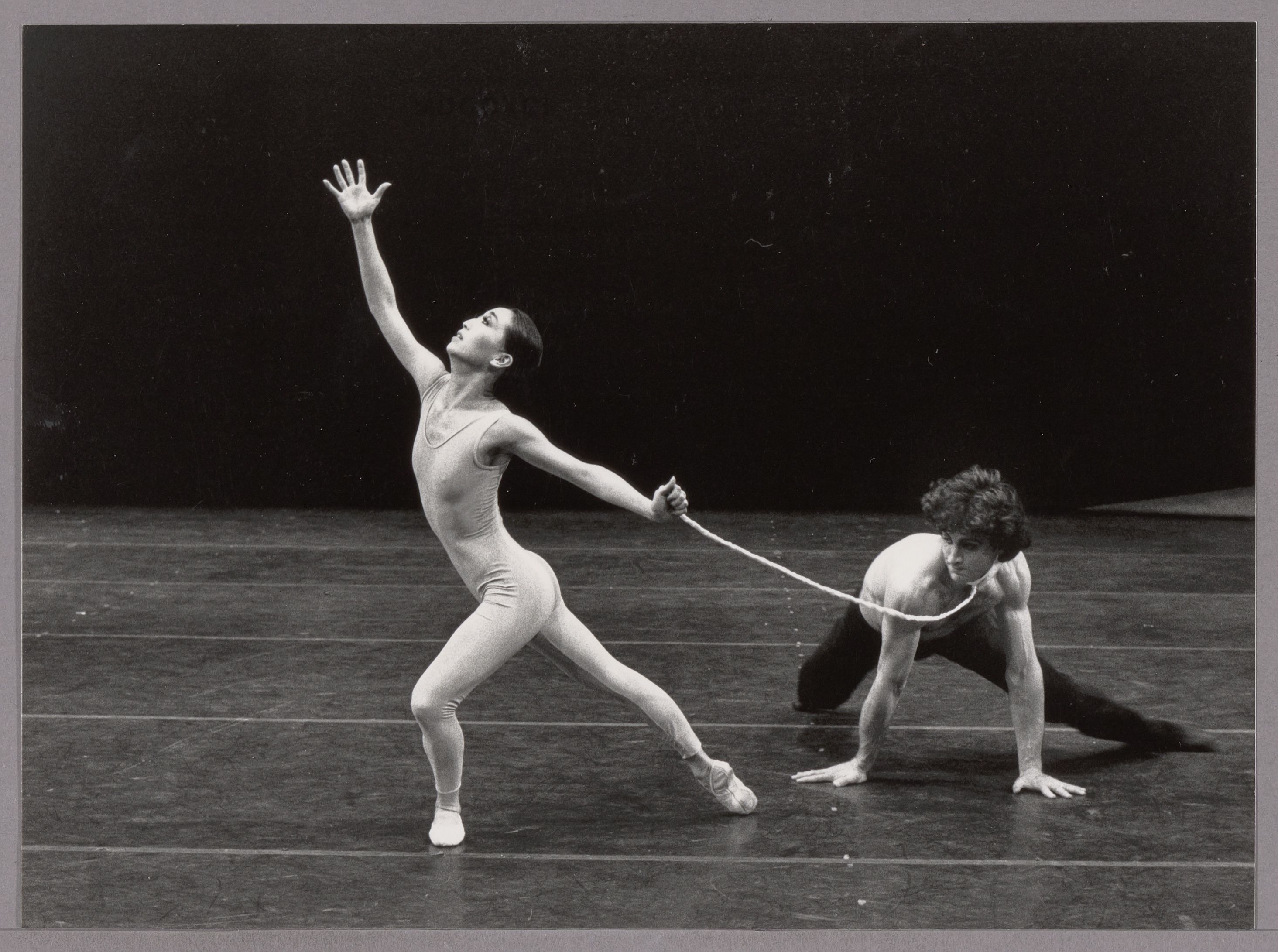
Requiem
The most important premiere this season is Toer van Schayk’s Requiem, set to Mozart’s music of the same name. The first run of performances is accompanied by the Nederlands Theaterkoor and four vocal soloists, alongside Dutch Ballet Orchestra.
Straight after the premiere, Anton Koolhaas writes in Vrij Nederland that the work is “a major acquisition for Dutch National Ballet”.
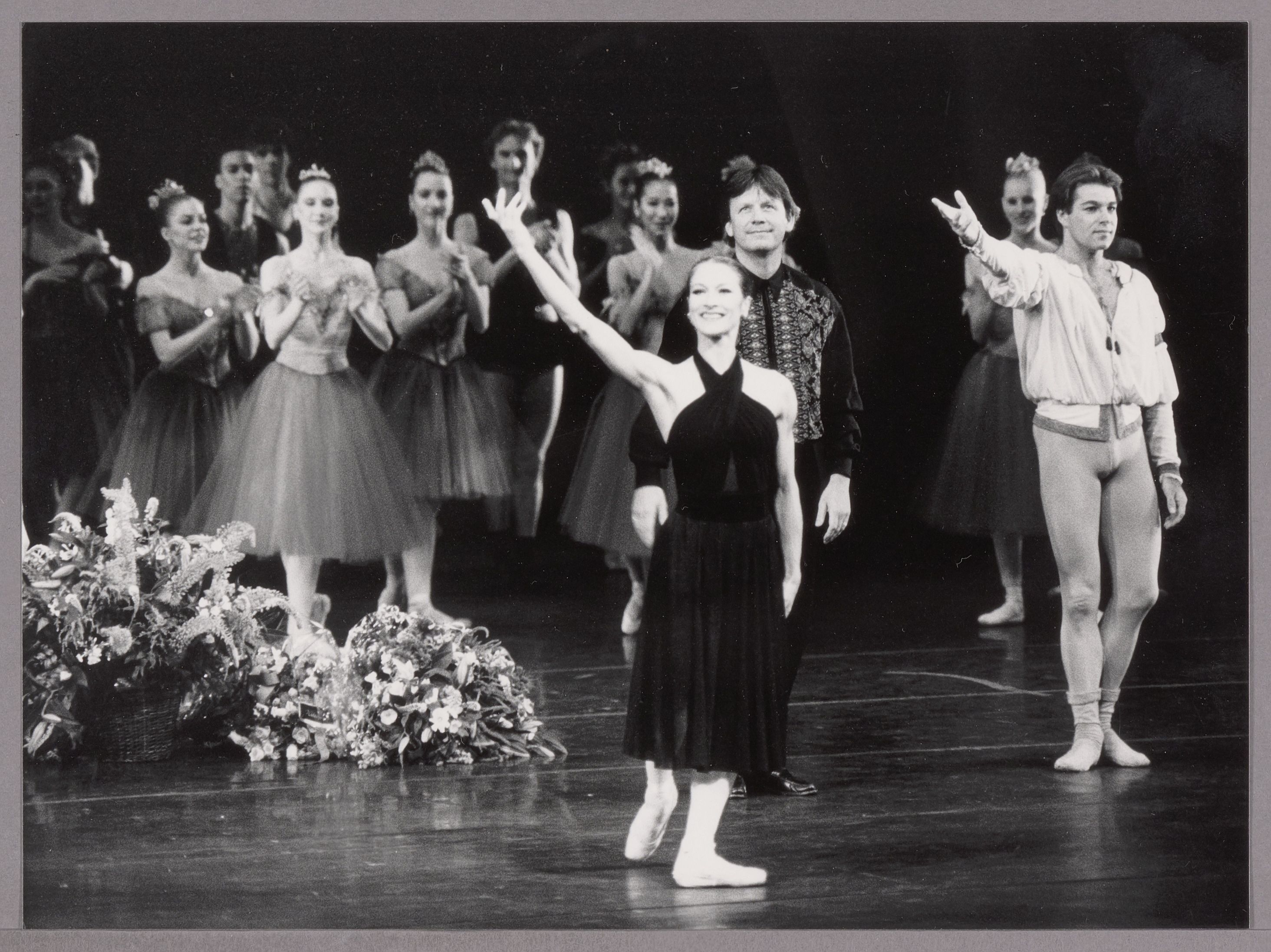
Departure of, and royal honour for Alexandra Radius
On 20 June 1990, principal dancer Alexandra Radius leaves Dutch National Ballet, at the age of nearly 48, which is exceptionally high for a ballet dancer. At her farewell performance, she dances Michel Fokine’s famous solo The Dying Swan, the balcony pas de deux from Rudi van Dantzig’s Romeo and Juliet and Hans van Manen’s De maan in de trapeze (from 1959) and Corps.
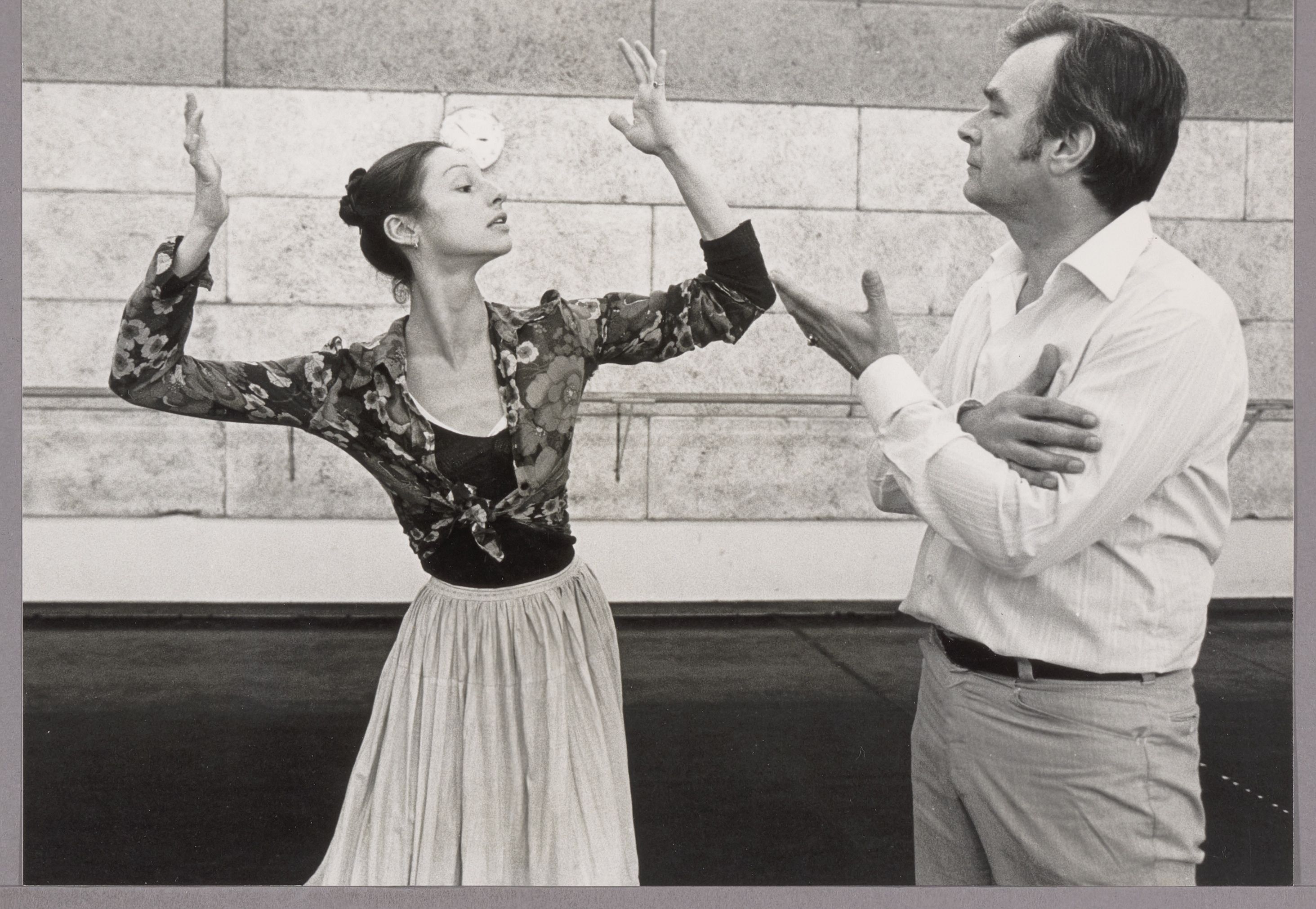
Joanne Zimmerman
Principal dancer Joanne Zimmerman also says farewell to the stage after 18 years with the company. In the latter years of her career, she was an unsurpassed Carabosse in Sir Peter Wright’s Sleeping Beauty, besides her interpretations of major roles in the works of Rudi van Dantzig, Toer van Schayk and George Balanchine. In 1991, Dansersfonds '79 honours her achievements by presenting her with its Merit Award.
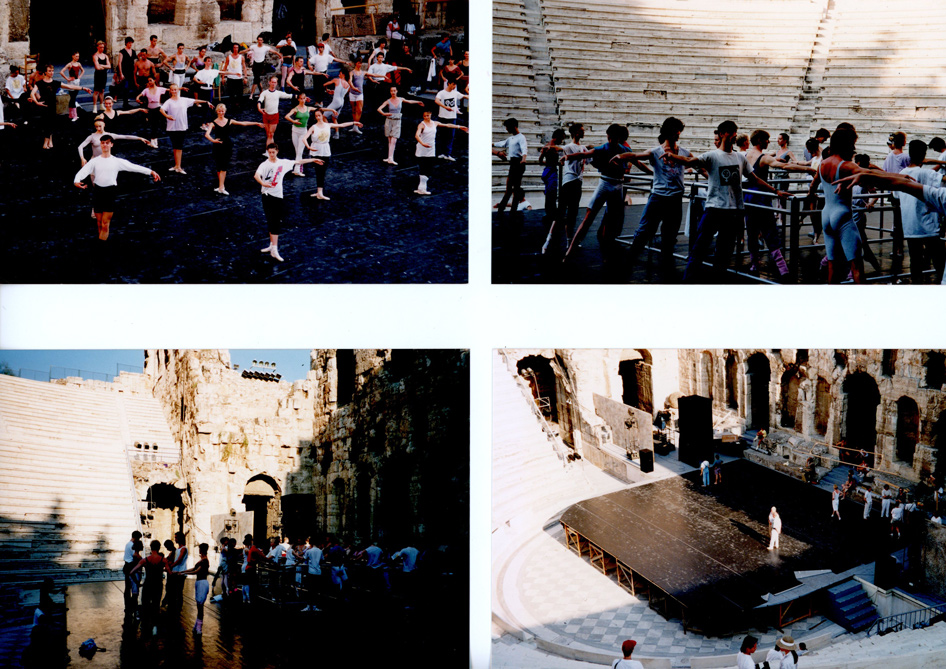
Second tour to Greece
At the end of the season, Dutch National Ballet performs for the second time at the Herodes Atticus open-air theatre, at the foot of the Acropolis, in Athens. Performances include works by Van Dantzig, Van Manen, Van Schayk and Balanchine.
90 / 91
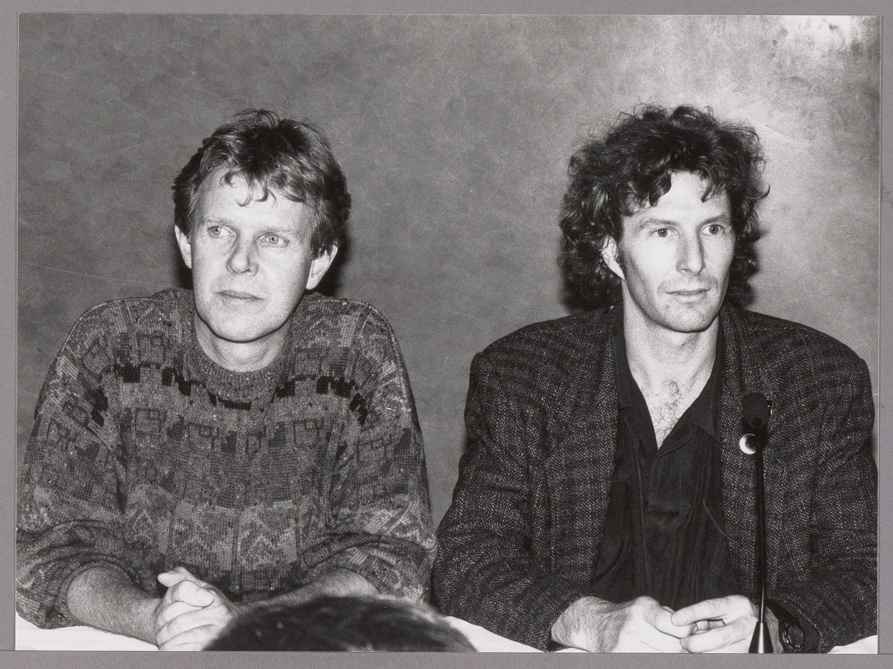
Wayne Eagling appointed advisor
Ahead of his appointment as artistic director, the Canadian dancer Wayne Eagling is appointed artistic advisor. At the time, Eagling is still with The Royal Ballet in London, at the end of his impressive career as a principal dancer.
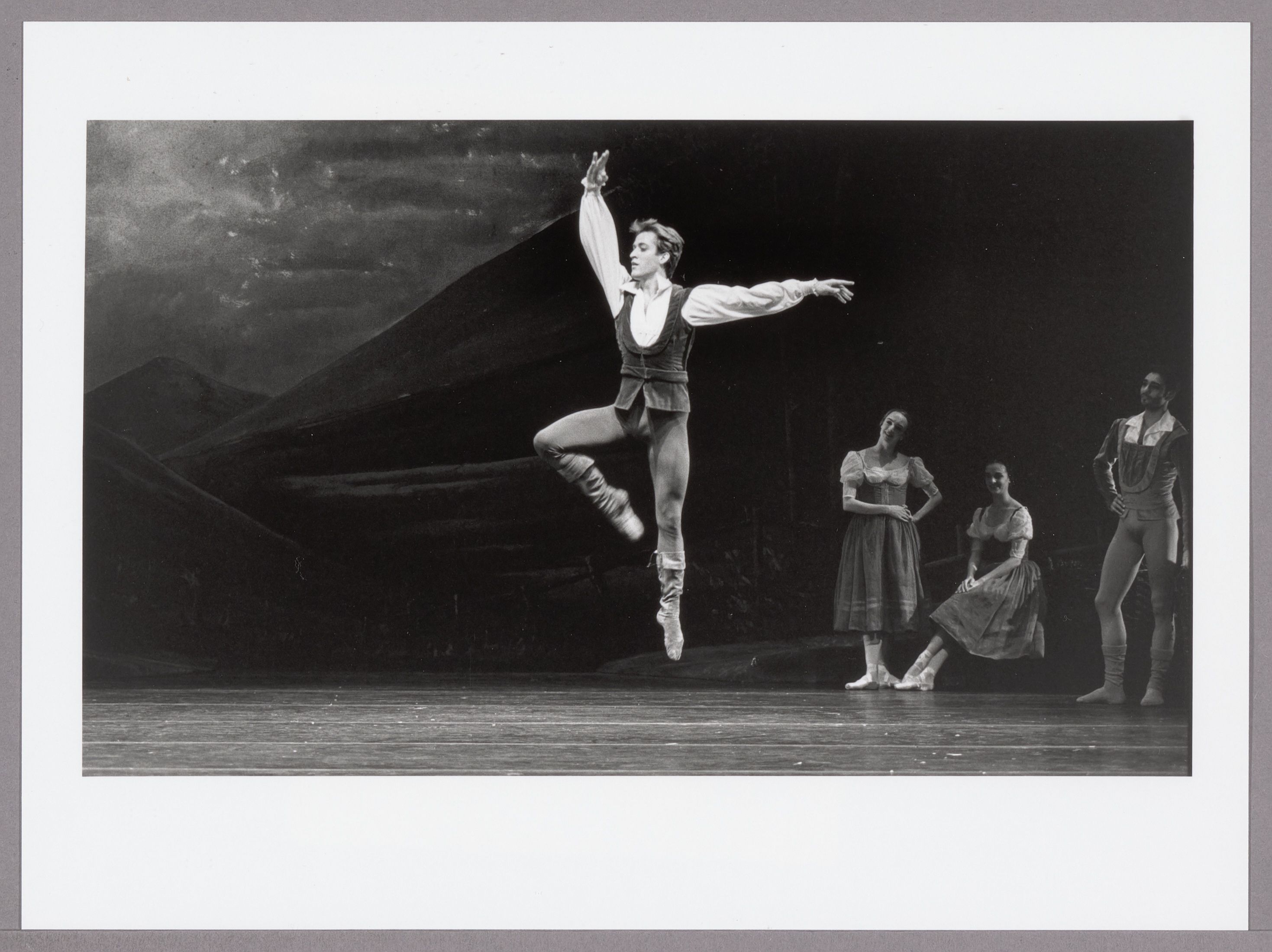
Golden Theatre Dance Prize for Alan Land
This season, principal dancer Alan Land receives the Golden Theatre Dance Prize from the VSCD, for his interpretations of the leading male roles in Giselle, Romeo and Juliet and Swan Lake, among others.
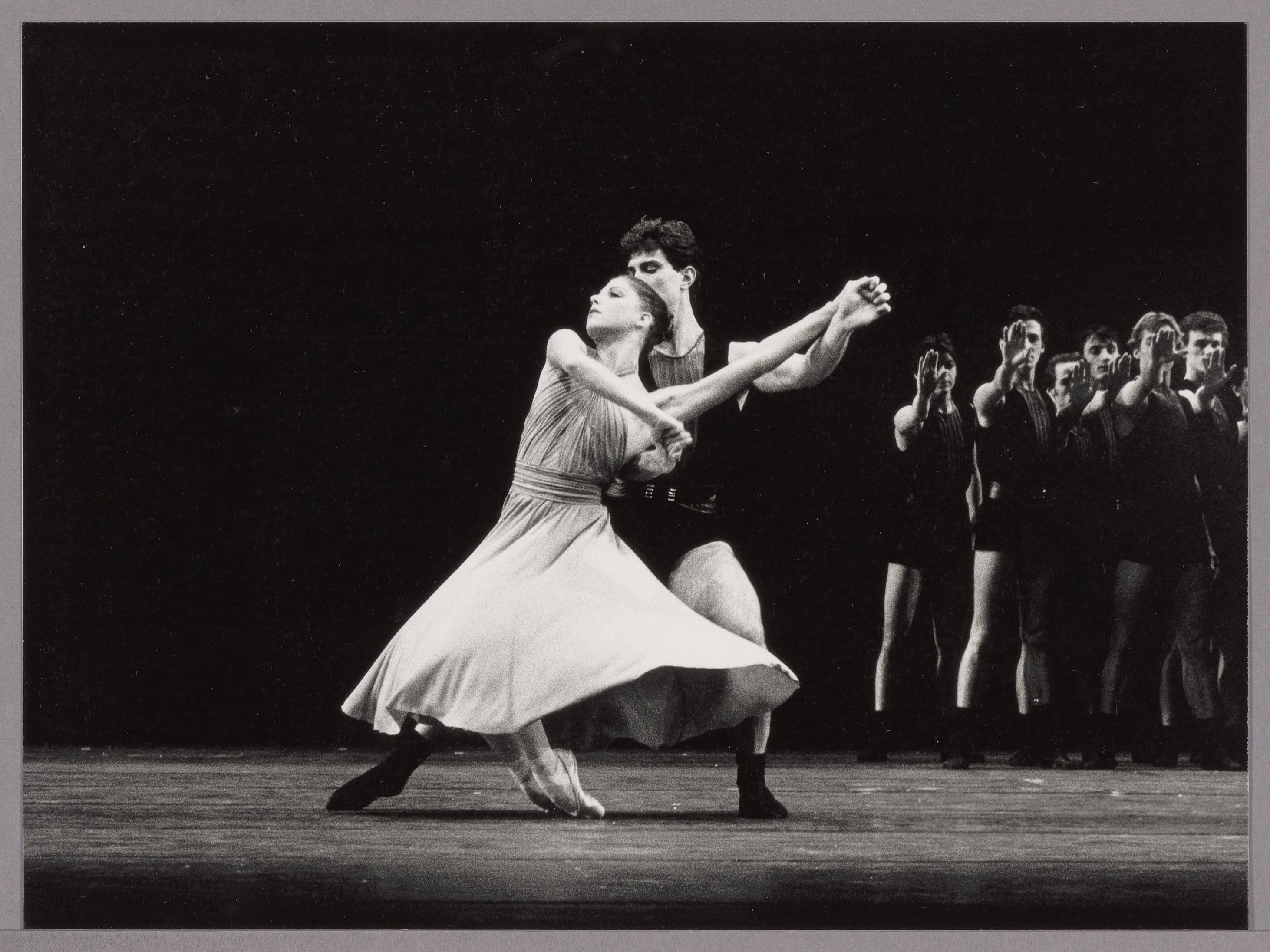
Silver wedding of Queen Beatrix and Prince Claus
On 11 May 1991, Dutch National Ballet dances Rudi van Dantzig’s Four Last Songs, Hans van Manen’s Corps and Toer van Schayk’s duet The Chimera of LA on the occasion of the silver wedding of Queen Beatrix and Prince Claus. The performance is broadcast live on television by the NOS.
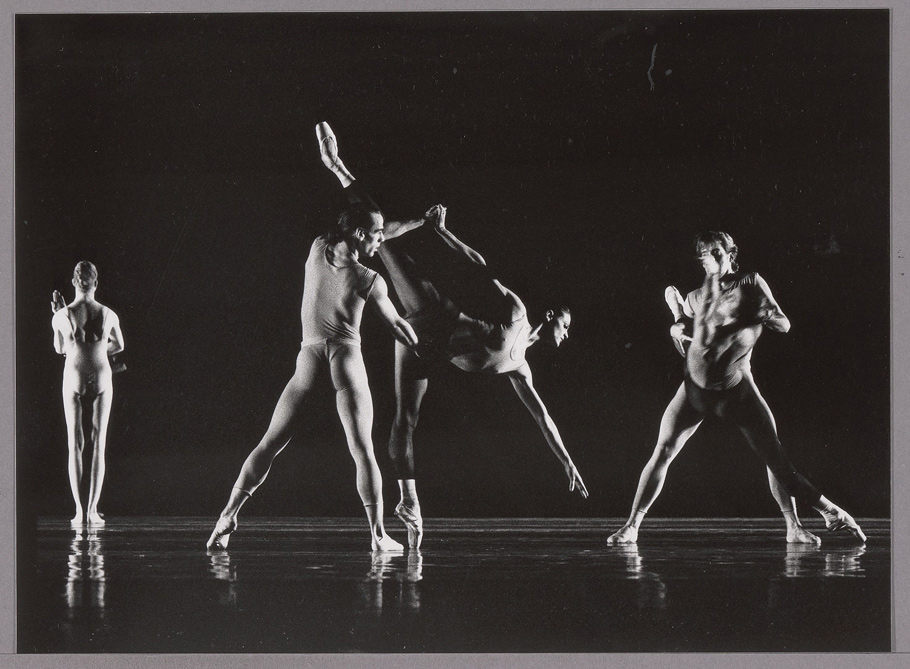
William Forsythe's Artifact
On the occasion of the 1991 Holland Festival, Dutch National Ballet presents part 2 of Artifact, the company’s first work by William Forsythe, one of the greatest dance innovators of the 20th century. Two years later, the company adds the complete ballet to its repertoire. Algemeen Dagblad describes the work as “masterly, overwhelming and impalpable”.
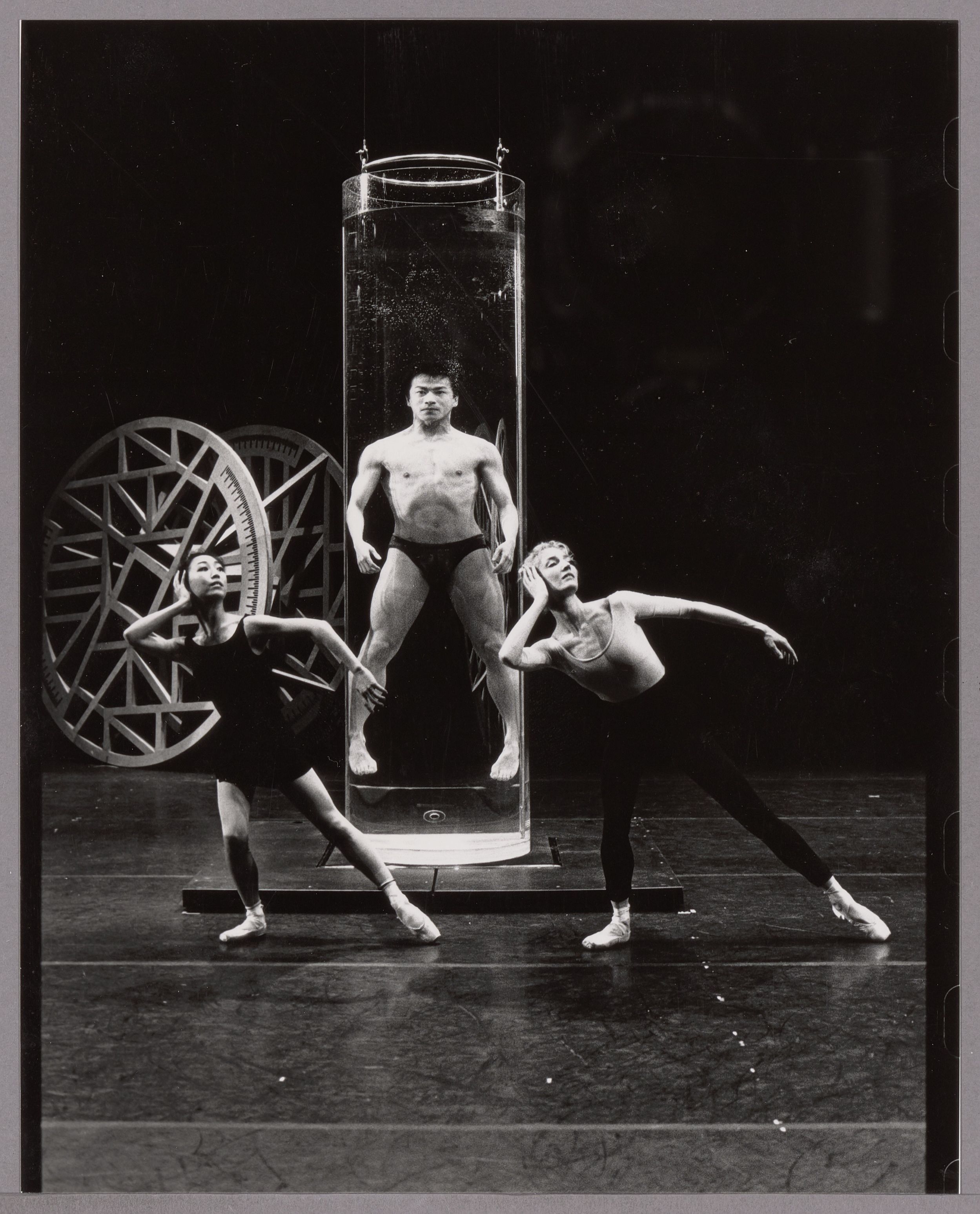
Pyrrhische Dansen IV and Les Noces
In the same edition of the Holland Festival, the company also dances the world premiere of Pyrrhische Dansen IV (the fourth part of a series of works by Van Schayk) and the Dutch premiere of Bronislava Nijinska's masterpiece Les Noces.
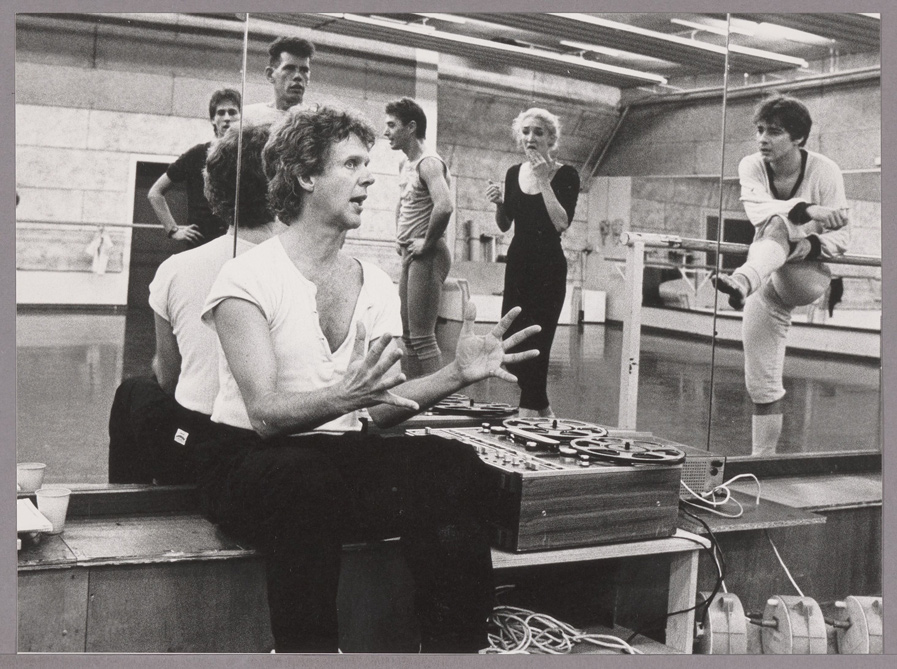
Farewell performance for Rudi van Dantzig
On 5 July 1991, Rudi van Dantzig leaves his position as artistic director of Dutch National Ballet. On the occasion, he is appointed Officer of the Order of Orange-Nassau, and the same title is awarded to managing director Anton Gerritsen, who has been with the company for 25 years. Van Dantzig remains with Dutch National Ballet as resident choreographer until 1994.
Romeo and Juliet in London
Following Van Dantzig’s farewell performance in the Netherlands, Dutch National Ballet gives six performances of his masterpiece Romeo and Juliet at the London Coliseum. The first night is attended by Princess Sarah Windsor-Ferguson, Duchess of York (as she was at the time). The renowned British dance critic John Percival writes in The Times, "Rudi van Dantzig's production of the Prokofiev Romeo and Juliet is probably the most clear and logical I have ever seen in its dramatic detail and development."
